Glossary
Plant Care Library
M
Madagascar Palm
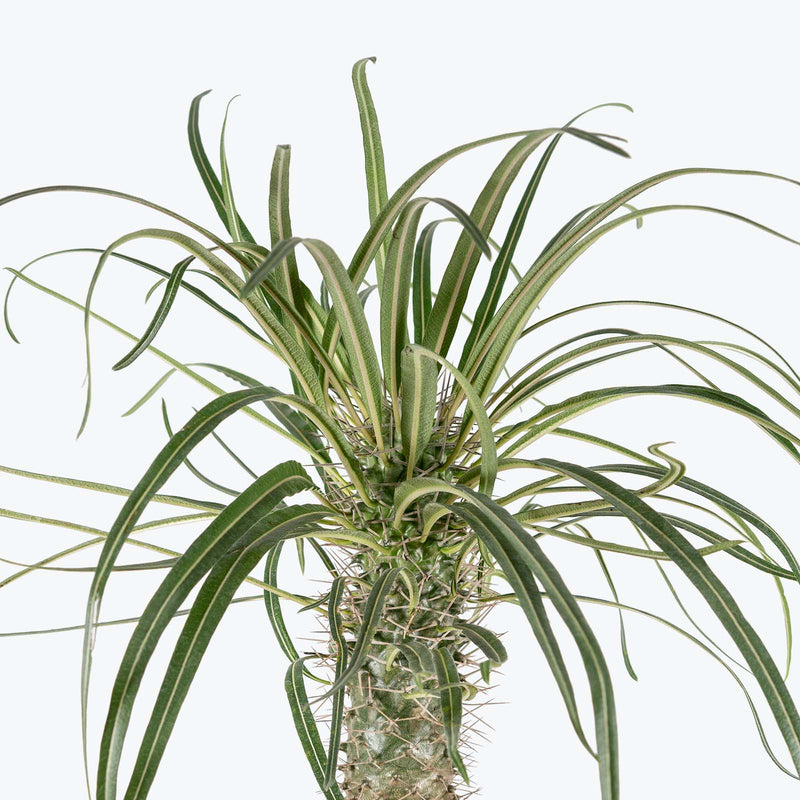
How to care for Madagascar Palm
They love as much sun as possible. The best spot for them is where they can see the sun during the majority of the day.
They will do best in bright light. A nice bright place inside your home would be on the window sill or a stool that is right next to a window, either with or without blinds, depending on if the plant can handle sun. Remember that plants will grow based on how much light they receive.
They like the soil to be relatively dry before the next watering. That usually takes about 2 weeks in an average home environment. It will vary depending on the time of year, your environment and lighting conditions, but for them, it's always safer to underwater or water when you see signs of lack of water (i.e. droopy, floppy, or soft leaves). Expect to water more often in brighter light and less often in lower light.
They can live in any average home humidity condition and are fairly hardy.
Madagascar Palms are best grown in well-draining soil and prefer a pot with good drainage. During the winter months, reduce watering significantly as the plant enters a dormant period.
This plant is moderately toxic and can cause some adverse reactions when ingested so it is best to not let your pets eat it, which we advise for all plants in general. The severity of the reaction will depend on how much of the plant is ingested but, if you know your pet typically does not eat your plants, this plant will be suitable for your home..
Learn MoreView PlantMajesty Palm
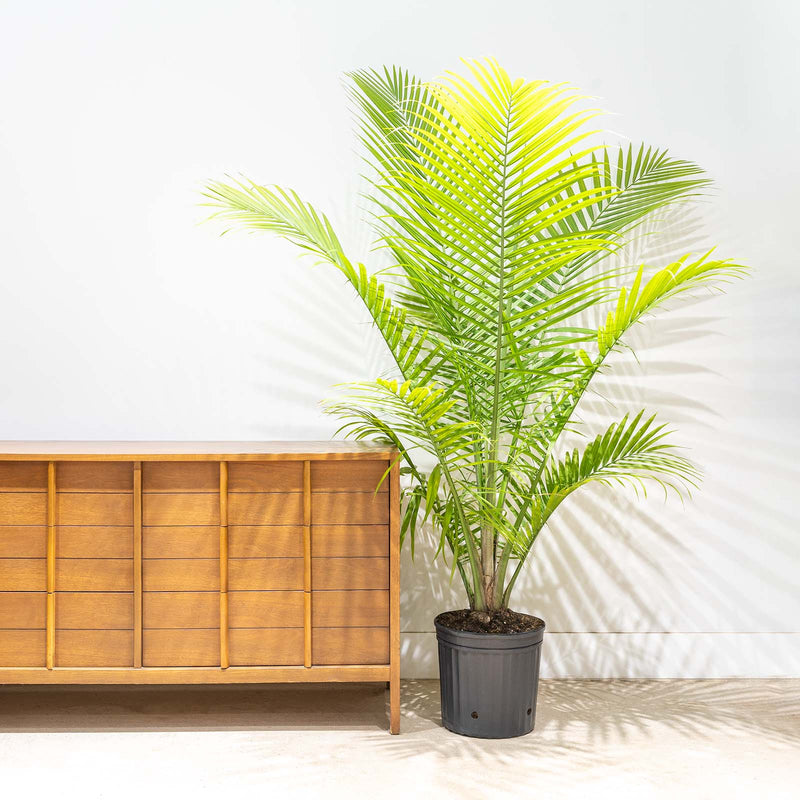
How to care for Majesty Palm
They should not be in a position to see the sun directly, although early morning or late evening sun is fine. Filtered sunlight through a sheer curtain is best and most homes are comprised primarily of indirect sunlight. The best spot for them is where they do not see the sun during the majority of the day but still get bright, indirect light.
They will do well in medium light but will grow faster with brighter light. A good medium-light place in your home would be in the middle of a room that has a regular size window. Remember that plants will grow based on how much light they receive.
They need to be watered when the top half of the soil is dry to the touch. That usually takes about 1 week in an average home environment. It will vary depending on the time of year, your environment and lighting conditions, but it's always safer to underwater or give the soil a check before you water again.
They will do well in average humidity environments but will appreciate a little bit of humidity if provided, give them a mist daily or get a humidifier.
The brown fronds do not necessarily indicate a problem, if it is being watered properly. They can be removed over time, if they turn brown or yellow, which allows for fresh space and energy to go towards new leaf growth. Like other palm trees, the fronds on your Majesty Palm will eventually die over time. Spider mite loves all palms, give your palm a shower every once a while or when you see them will keep them away.
You can feel comfortable having this plant around your home in the potential case where your pet feels like nibbling on it. However, we typically recommend keeping your pets from eating any of your houseplants..
Learn MoreView PlantMandevilla
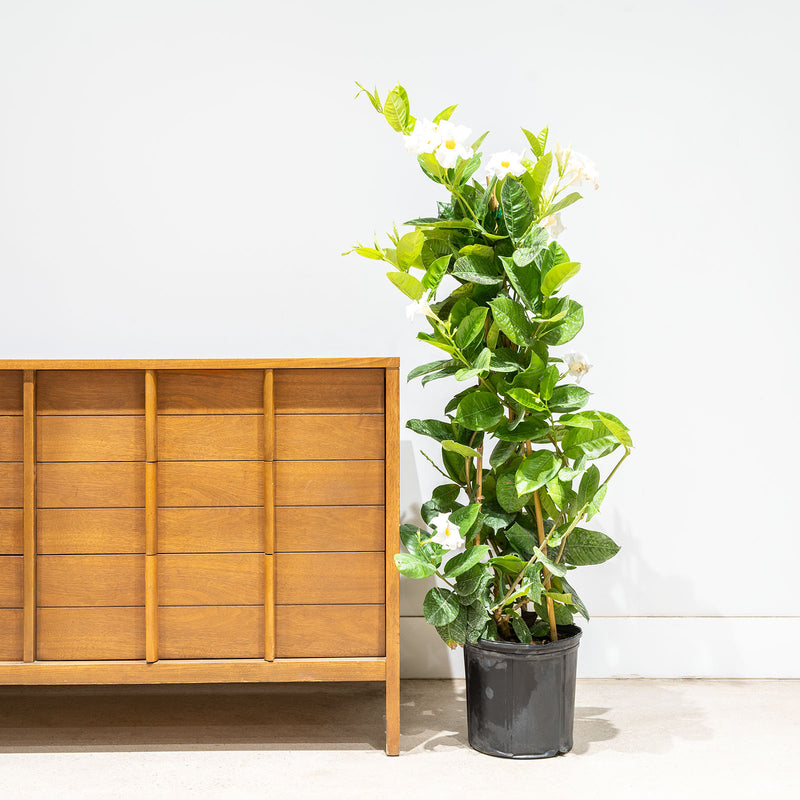
How to care for Mandevilla
They love as much heat and sun as possible. The best spot for them is where they can see the sun during the majority of the day.
They will do their best and flower profusely in bright light. A nice bright place outside would be on a sunny balcony, deck, or backyard; inside your home, it would do best in a sunny window sill. Remember that plants will grow and flower based on how much light they receive.
They need to be watered when the top half of the soil is dry to the touch. When outside, how fast the soil dries will depend on how sunny and warm the days are, so check your plant daily. Indoors, that can take about 1 week, but it will vary depending on the time of year, the environment, and lighting conditions. It's safer to underwater, or check the soil, before you water again, especially during the winter. Expect to water more often in the summer and less often in the winter.
They like a high humidity environment. Outdoors, this should happen naturally in the summer, but indoors, give them a mist daily or as often as possible. Alternatively, you can put them around a humidifier. Although they won't die if they don't receive enough humidity, their leaves may have some dry, crunchy, or yellow edges.
In order for them to bloom steadily, they truly need 6-8 hours of direct sunlight. Their stunning flowers will add pops of colour to your home, balcony, or yard. Fertilize every 2 weeks in the growing season with diluted, liquid fertilizer. Since they are relatively drought-tolerant, they are a great pick for busy or forgetful gardeners who may forget to water from time to time. To overwinter your plant, bring them inside and keep them in a window that receives sun all day, only watering when the top half of the soil is dry. Some foliage may die but they should produce new foliage in the Spring again.
This plant is extremely toxic to pets and should not be kept around any animals that have a tendency to eat houseplants as it will lead to severe reactions..
View PlantMaranta Black Prayer Plant
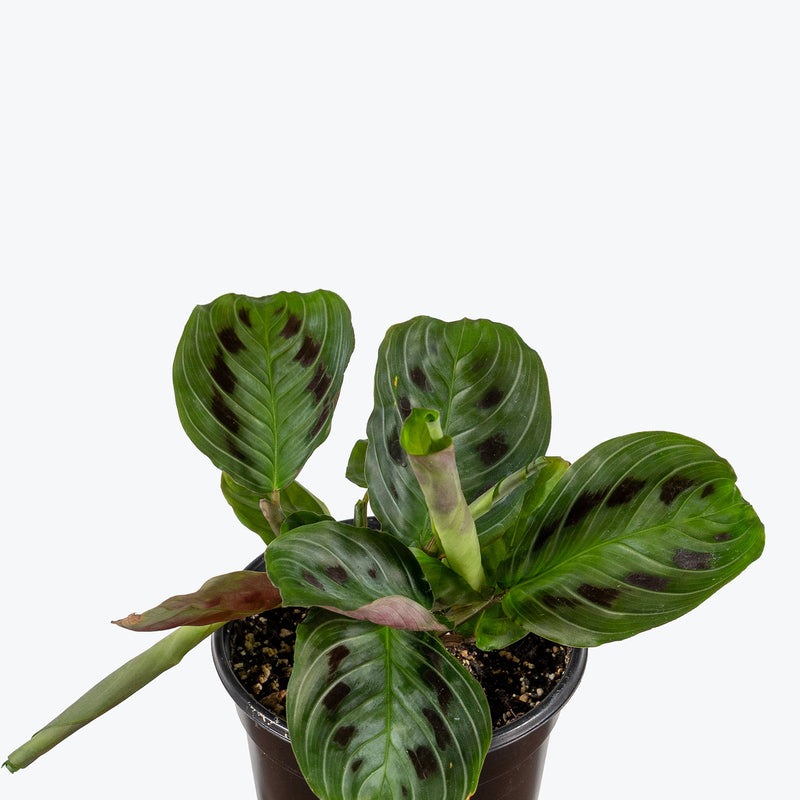
How to care for Maranta Black Prayer Plant
Maranta Black Prayer Plant should not be in a position to see the sun directly, although early morning or late evening sun is fine. Filtered sunlight through a sheer curtain is best and most homes are comprised primarily of indirect sunlight. The best spot for them is where they do not see the sun during the majority of the day but still get bright, indirect light.
Maranta Black Prayer Plant will thrive in bright light, but also can tolerate medium light. A good medium-light place in your home would be in the middle of a room that has a regular size window. They can be placed anywhere between the middle of the room and the window. Remember that plants will grow based on how much light they receive.
Maranta Black Prayer Plant needs to be watered when the top half of the soil is dry to the touch. That usually takes about 1 week in an average home environment. It will vary depending on the time of year, your environment and lighting conditions, but it's always safer to underwater or give the soil a check before you water again.
Maranta Black Prayer Plant will do well in average humidity environments but will appreciate a little bit of humidity if provided, give them a mist daily or get a humidifier.
Keep Maranta Black Prayer Plant in a well-draining, peat-rich soil and water consistently to avoid extremes. Turn the pot regularly to maintain even growth. Prayer plants benefit from low-dose fertilizer every 4–6 weeks during the growing season. Wipe the leaves occasionally to remove dust and help with light absorption.
You can feel comfortable having Maranta Black Prayer Plant around your home in the potential case where your pet feels like nibbling on it. However, we typically recommend keeping your pets from eating any of your houseplants..
View PlantMaranta Green Prayer Plant
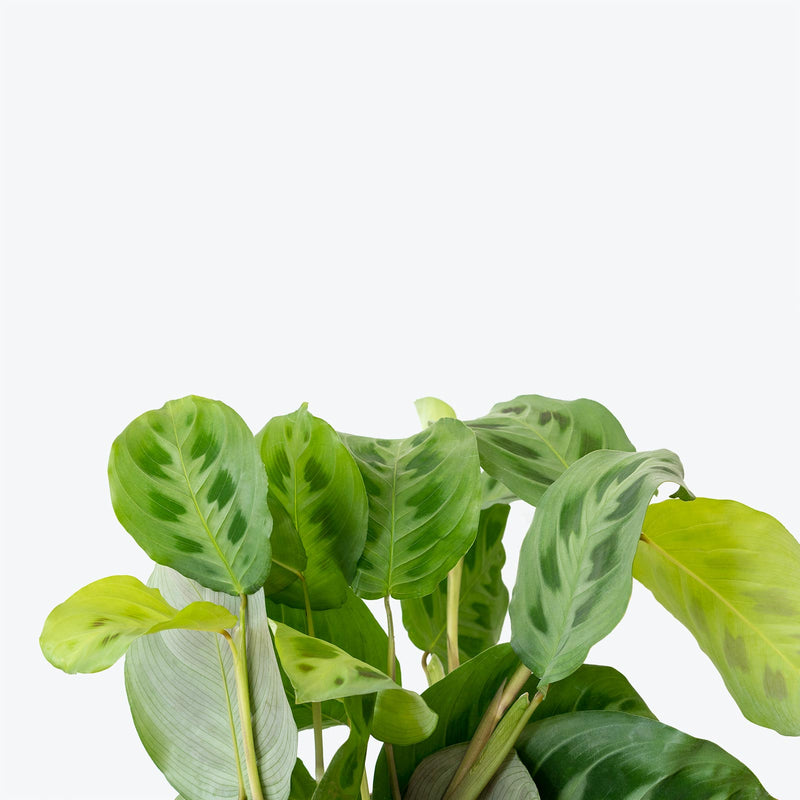
How to care for Maranta Green Prayer Plant
They should not be in a position to see the sun directly, although early morning or late evening sun is fine. Filtered sunlight through a sheer curtain is best and most homes are comprised primarily of indirect sunlight. The best spot for them is where they do not see the sun during the majority of the day but still get bright, indirect light.
They will do well in medium light but will grow faster with brighter light. A good medium-light place in your home would be in the middle of a room that has a regular size window. Remember that plants will grow based on how much light they receive.
They need to be watered when the top half of the soil is dry to the touch. That usually takes about 1 week in an average home environment. It will vary depending on the time of year, your environment and lighting conditions, but it's always safer to underwater or give the soil a check before you water again.
They like a high humidity environment, give them a mist daily or as often as possible. Alternatively, you can put them around a humidifier. Although they won't die if they don't receive enough humidity, their leaves may have some dry, crunchy, or yellow edges.
If your maranta fades in colour or becomes washed out, it might be receiving too much direct sun. Their leaves tend to move throughout the day, which is how they got the name "prayer plant".
You can feel comfortable having this plant around your home in the potential case where your pet feels like nibbling on it. However, we typically recommend keeping your pets from eating any of your houseplants..
View PlantMaranta Light Veins
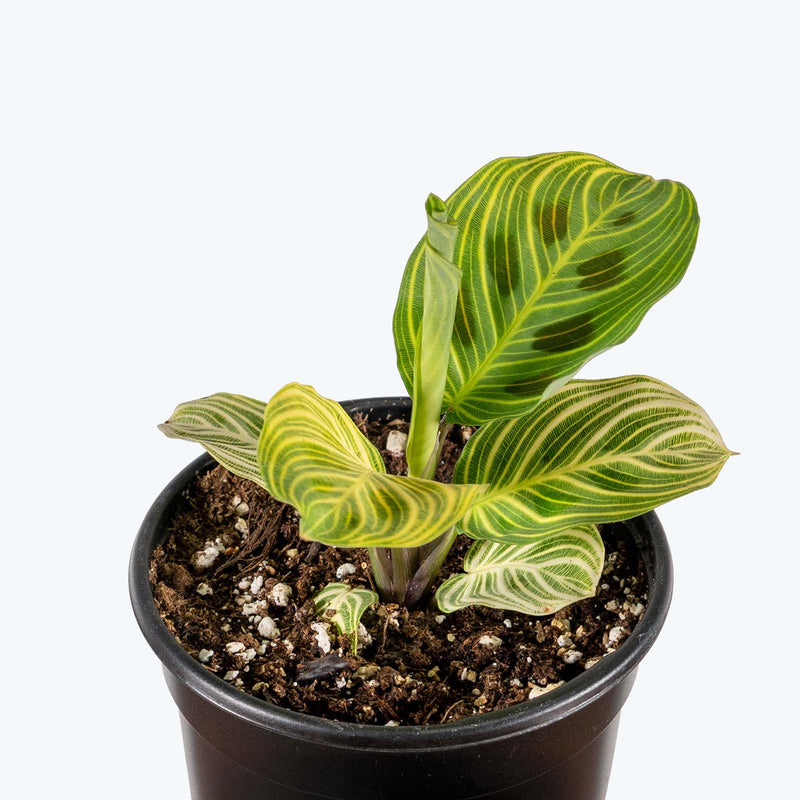
How to care for Maranta Light Veins
Maranta Light Veins should not be in a position to see the sun directly, although early morning or late evening sun is fine. Filtered sunlight through a sheer curtain is best and most homes are comprised primarily of indirect sunlight. The best spot for them is where they do not see the sun during the majority of the day but still get bright, indirect light.
Maranta Light Veins will thrive in bright light, but also can tolerate medium light. A good medium-light place in your home would be in the middle of a room that has a regular size window. They can be placed anywhere between the middle of the room and the window. Remember that plants will grow based on how much light they receive.
Maranta Light Veins needs to be watered when the top half of the soil is dry to the touch. That usually takes about 1 week in an average home environment. It will vary depending on the time of year, your environment and lighting conditions, but it's always safer to underwater or give the soil a check before you water again.
Maranta Light Veins likes a high humidity environment, give them a mist daily or as often as possible. Alternatively, you can put them around a humidifier. Although they won't die if they don't receive enough humidity, their leaves may have some dry, crunchy, or yellow edges.
Keep Maranta Light Veins in well-draining soil, and avoid cold drafts or sudden temperature changes. Wipe the leaves occasionally to keep them dust-free and looking vibrant. Fertilize lightly every 4–6 weeks during spring and summer. Rotate the pot every couple of weeks for even growth.
You can feel comfortable having Maranta Light Veins around your home in the potential case where your pet feels like nibbling on it. However, we typically recommend keeping your pets from eating any of your houseplants..
View PlantMaranta Neon Prayer Plant
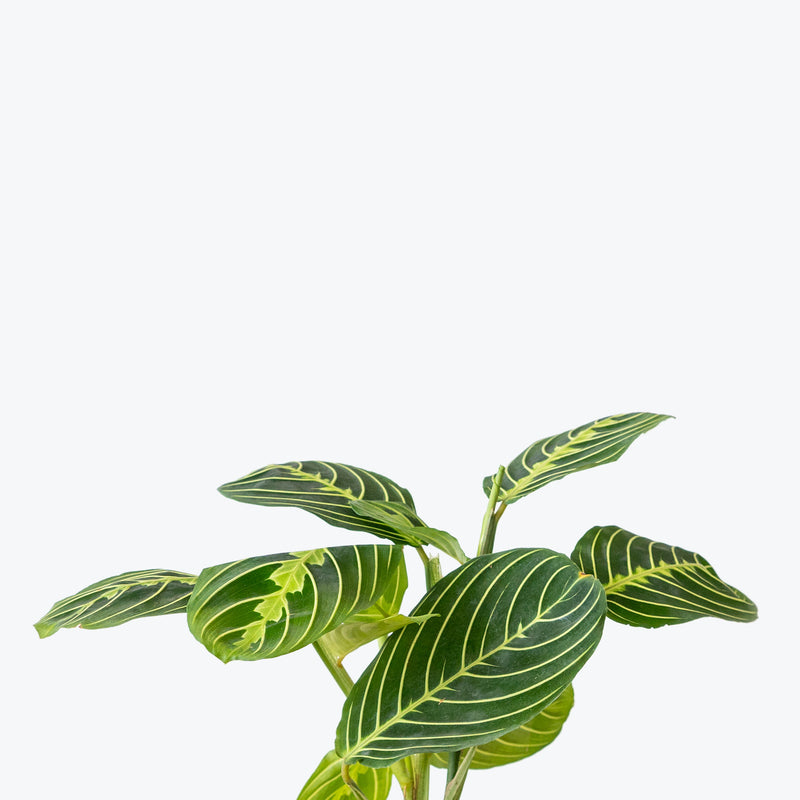
How to care for Maranta Neon Prayer Plant
They should not be in a position to see the sun directly, although early morning or late evening sun is fine. Filtered sunlight through a sheer curtain is best and most homes are comprised primarily of indirect sunlight. The best spot for them is where they do not see the sun during the majority of the day but still get bright, indirect light.
They will do well in medium light but will grow faster with brighter light. A good medium-light place in your home would be in the middle of a room that has a regular size window. Remember that plants will grow based on how much light they receive.
They need to be watered when the top half of the soil is dry to the touch. That usually takes about 1 week in an average home environment. It will vary depending on the time of year, your environment and lighting conditions, but it's always safer to underwater or give the soil a check before you water again.
They like a high humidity environment, give them a mist daily or as often as possible. Alternatively, you can put them around a humidifier. Although they won't die if they don't receive enough humidity, their leaves may have some dry, crunchy, or yellow edges.
If your maranta fades in colour or becomes washed out, it might be receiving too much direct sun. Their leaves tend to move throughout the day, which is how they got the name "prayer plant"
You can feel comfortable having this plant around your home in the potential case where your pet feels like nibbling on it. However, we typically recommend keeping your pets from eating any of your houseplants..
View PlantMaranta Red Prayer Plant
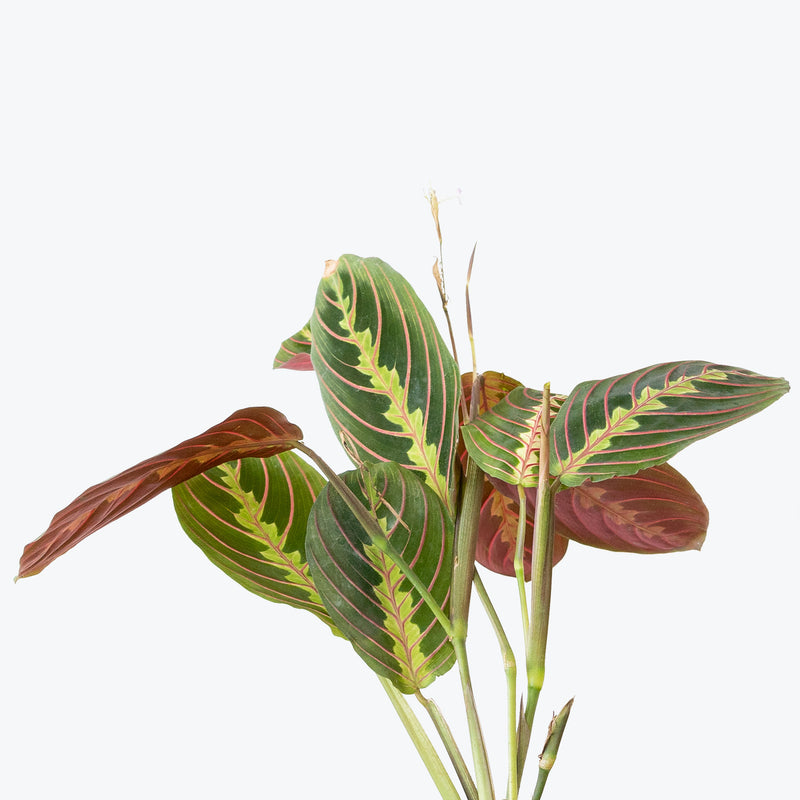
How to care for Maranta Red Prayer Plant
They should not be in a position to see the sun directly, although early morning or late evening sun is fine. Filtered sunlight through a sheer curtain is best and most homes are comprised primarily of indirect sunlight. The best spot for them is where they do not see the sun during the majority of the day but still get bright, indirect light.
They will do well in medium light but will grow faster with brighter light. A good medium-light place in your home would be in the middle of a room that has a regular size window. Remember that plants will grow based on how much light they receive.
They need to be watered when the top half of the soil is dry to the touch. That usually takes about 1 week in an average home environment. It will vary depending on the time of year, your environment and lighting conditions, but it's always safer to underwater or give the soil a check before you water again.
They like a high humidity environment, give them a mist daily or as often as possible. Alternatively, you can put them around a humidifier. Although they won't die if they don't receive enough humidity, their leaves may have some dry, crunchy, or yellow edges.
If your maranta fades in colour or becomes washed out, it might be receiving too much direct sun. Their leaves tend to move throughout the day, which is how they got the name "prayer plant"
You can feel comfortable having this plant around your home in the potential case where your pet feels like nibbling on it. However, we typically recommend keeping your pets from eating any of your houseplants..
View PlantMaranta Silver Band
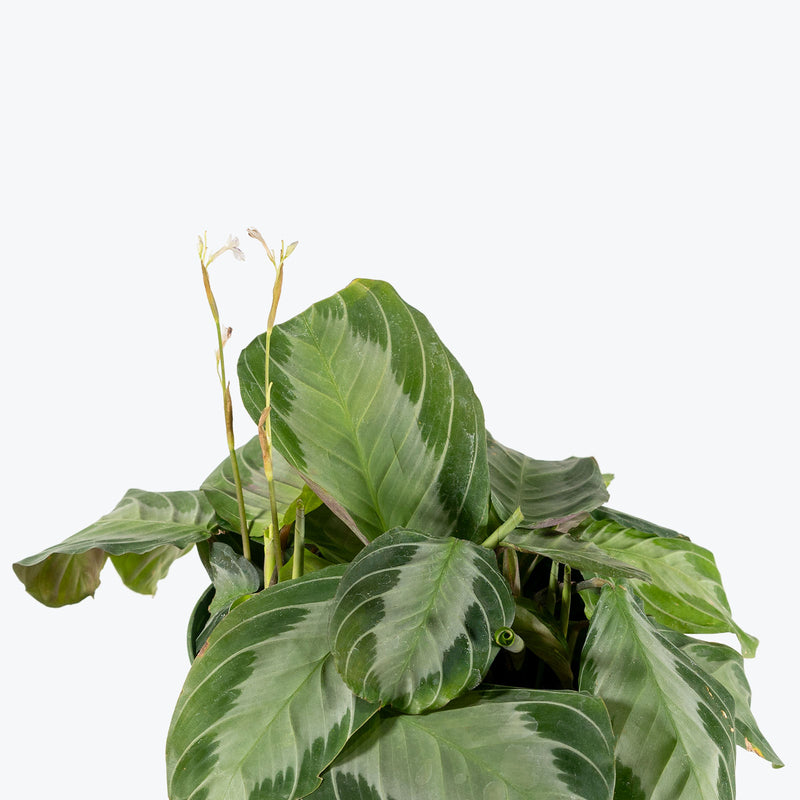
How to care for Maranta Silver Band
Maranta Silver Band should not be in a position to see the sun directly, although early morning or late evening sun is fine. Filtered sunlight through a sheer curtain is best and most homes are comprised primarily of indirect sunlight. The best spot for them is where they do not see the sun during the majority of the day but still get bright, indirect light.
Maranta Silver Band will thrive in bright light, but also can tolerate medium light. A good medium-light place in your home would be in the middle of a room that has a regular size window. They can be placed anywhere between the middle of the room and the window. Remember that plants will grow based on how much light they receive.
Maranta Silver Band needs to be watered when the top half of the soil is dry to the touch. That usually takes about 1 week in an average home environment. It will vary depending on the time of year, your environment and lighting conditions, but it's always safer to underwater or give the soil a check before you water again.
Maranta Silver Band likes a high humidity environment, give them a mist daily or as often as possible. Alternatively, you can put them around a humidifier. Although they won't die if they don't receive enough humidity, their leaves may have some dry, crunchy, or yellow edges.
Fertilize your Maranta 'Silver Band' every 4-6 weeks during the growing season with a diluted, balanced liquid fertilizer. Rotate the plant regularly to ensure even growth on all sides. Prune back any leggy growth to encourage a fuller, bushier plant.
You can feel comfortable having Maranta Silver Band around your home in the potential case where your pet feels like nibbling on it. However, we typically recommend keeping your pets from eating any of your houseplants..
View PlantMaranta Variegated Prayer Plant
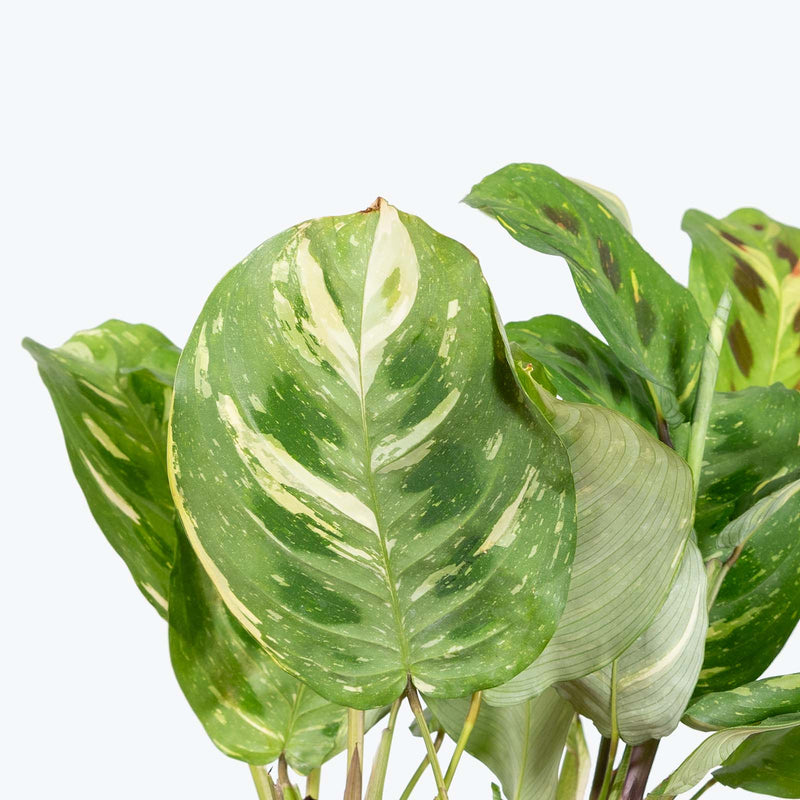
How to care for Maranta Variegated Prayer Plant
They should not be in a position to see the sun directly, although early morning or late evening sun is fine. Filtered sunlight through a sheer curtain is best and most homes are comprised primarily of indirect sunlight. The best spot for them is where they do not see the sun during the majority of the day but still get bright, indirect light.
They will do well in medium light but will grow faster with brighter light. A good medium-light place in your home would be in the middle of a room that has a regular size window. Remember that plants will grow based on how much light they receive.
They need to be watered when the top half of the soil is dry to the touch. That usually takes about 1 week in an average home environment. It will vary depending on the time of year, your environment and lighting conditions, but it's always safer to underwater or give the soil a check before you water again.
They like a high humidity environment, give them a mist daily or as often as possible. Alternatively, you can put them around a humidifier. Although they won't die if they don't receive enough humidity, their leaves may have some dry, crunchy, or yellow edges.
Being sensitive to water quality, it's best to use distilled or rainwater for watering. If you notice brown tips or edges on the leaves, it could be a sign of low humidity or fluoridated tap water. Gently wipe the leaves with a damp cloth periodically to remove dust.
You can feel comfortable having this plant around your home in the potential case where your pet feels like nibbling on it. However, we typically recommend keeping your pets from eating any of your houseplants..
View PlantMarsh Pennywort
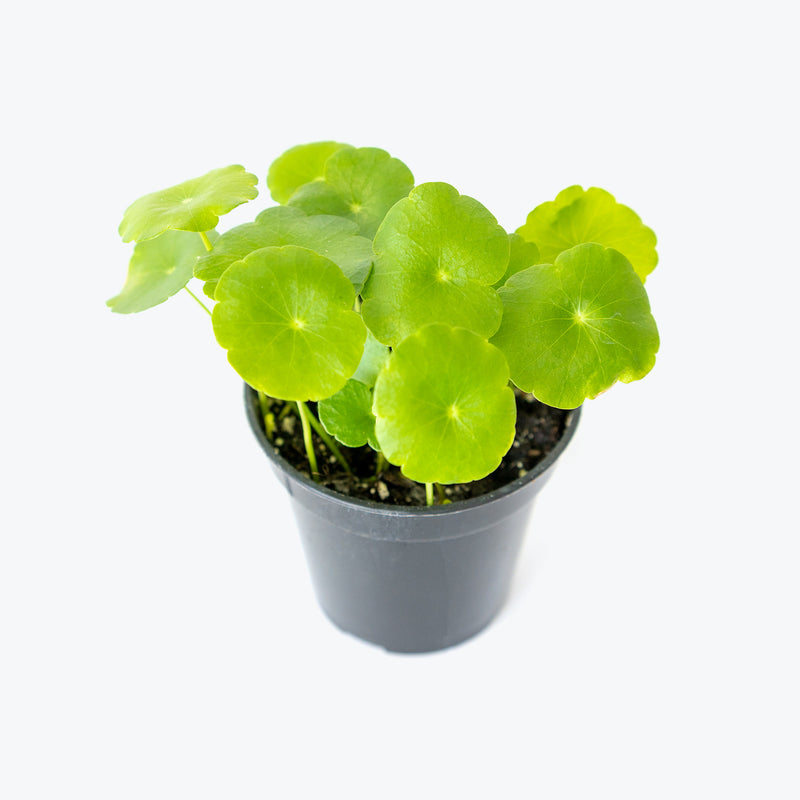
How to care for Marsh Pennywort
They enjoy some direct sun, but they'll also do well in bright, indirect light. It is best to place this plant somewhere where it will receive some nice morning sun, or a couple hours of afternoon sun, and then indirect light the rest of the day.
They will do well in medium light but will grow faster with brighter light. A good medium-light place in your home would be in the middle of a room that has a regular size window. Remember that plants will grow based on how much light they receive.
They like the soil to stay consistently moist, but not soaking wet. Give them water whenever just the surface of the soil is starting to get dry.
They will do well in average humidity environments but will appreciate a little bit of humidity if provided, give them a mist daily or get a humidifier.
Marsh Pennywort is the plant you don't need to worry about overwatering, as they can literally grow in water. It is also the plant you can't kill, because even if the whole plant dried out, you can cut the dry leaves off, add water to the pot, and they'll grow back!
You can feel comfortable having this plant around your home in the potential case where your pet feels like nibbling on it. However, we typically recommend keeping your pets from eating any of your houseplants..
View PlantMexican Fence Post Cactus

How to care for Mexican Fence Post Cactus
Mexican Fence Post Cactus enjoys some direct sun, but they'll also do well in bright, indirect light. It is best to place this plant somewhere where it will receive some nice morning sun, or a couple hours of afternoon sun, and then indirect light the rest of the day.
Mexican Fence Post Cactus will do best in bright light. A nice bright place inside your home would be on the window sill or a stool that is right next to a window, either with or without blinds, depending on if the plant can handle sun. Remember that plants will grow based on how much light they receive.
Mexican Fence Post Cactus likes the soil to be completely dry before the next watering. That usually takes about 4 weeks in an average home environment. It will vary depending on the time of year, your environment and lighting conditions, but for them, it's always safer to underwater or water when you see signs of lack of water (i.e. wrinkly or soft leaves). Water a little more often in the warmer months.
Their humidity requirement is low, so do not mist Mexican Fence Post Cactus or put them in a terrarium.
When planting or repotting Mexican Fence Post Cactus, use a well-draining cactus or succulent mix to ensure proper drainage. Fertilize sparingly; once in the early spring with a liquid fertilizer can be enough to support its growth for the year. Being a slow-grower, it doesn't require frequent repotting—once every few years is generally sufficient.
Mexican Fence Post Cactus is moderately toxic and can cause some adverse reactions when ingested so it is best to not let your pets eat it, which we advise for all plants in general. The severity of the reaction will depend on how much of the plant is ingested but, if you know your pet typically does not eat your plants, this plant will be suitable for your home..
Learn MoreView PlantMini Cactus Mystery Box
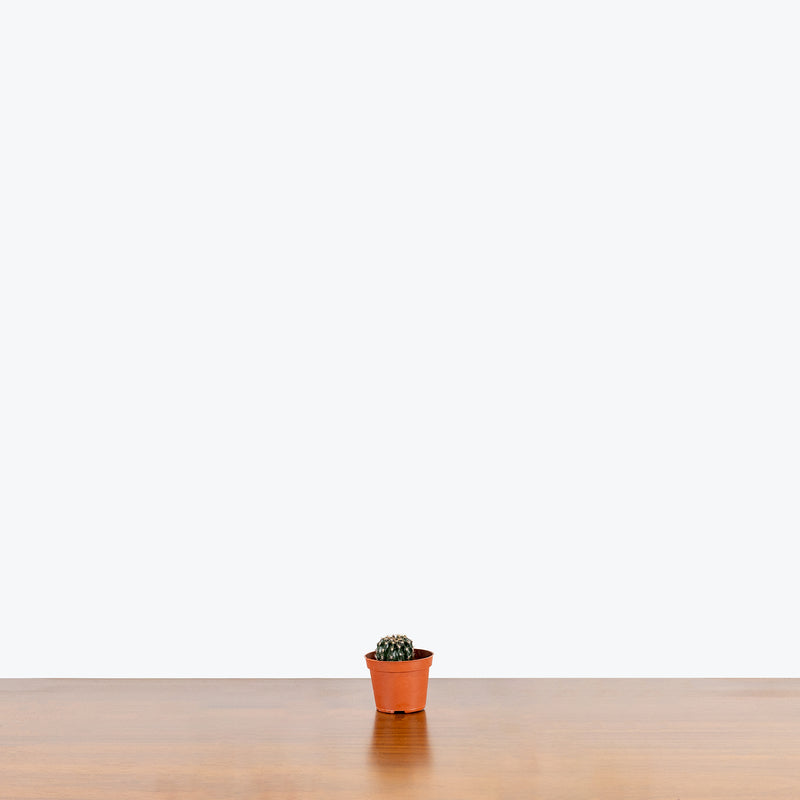
How to care for Mini Cactus Mystery Box
They enjoy some direct sun, but they'll also do well in bright, indirect light. It is best to place this plant somewhere where it will receive some nice morning sun, or a couple hours of afternoon sun, and then indirect light the rest of the day.
They will do best in bright light. A nice bright place inside your home would be on the window sill or a stool that is right next to a window, either with or without blinds, depending on if the plant can handle sun. Remember that plants will grow based on how much light they receive.
They like the soil to be completely dry before the next watering. That usually takes about 4 weeks in an average home environment. It will vary depending on the time of year, your environment and lighting conditions, but for them, it's always safer to underwater or water when you see signs of lack of water (i.e. wrinkly or soft leaves).
Their humidity requirement is low, so do not mist them or put them in an enclosed terrarium.
As with all succulents, overwatering is sure to be fatal, so err on the side of too dry rather than too wet, never letting it sit in water. If the side of the plant facing the sun starts to turn yellow or brown, move the plant to a spot where it will receive less direct sunlight than it was receiving.
This plant is moderately toxic and can cause some adverse reactions when ingested so it is best to not let your pets eat it, which we advise for all plants in general. The severity of the reaction will depend on how much of the plant is ingested but, if you know your pet typically does not eat your plants, this plant will be suitable for your home..
Learn MoreView PlantMini Cactus Succulent Greenhouse
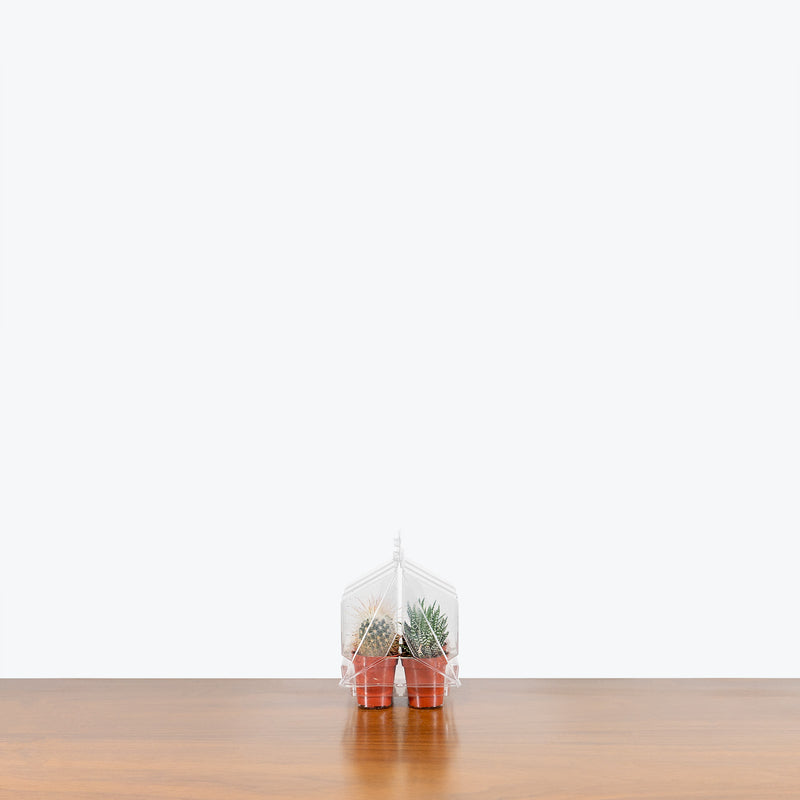
How to care for Mini Cactus Succulent Greenhouse
They enjoy some direct sun, but they'll also do well in bright, indirect light. It is best to place this plant somewhere where it will receive some nice morning sun, or a couple hours of afternoon sun, and then indirect light the rest of the day.
They will do best in bright light. A nice bright place inside your home would be on the window sill or a stool that is right next to a window, either with or without blinds, depending on if the plant can handle sun. Remember that plants will grow based on how much light they receive.
They like the soil to be completely dry before the next watering. That usually takes about 4 weeks in an average home environment. It will vary depending on the time of year, your environment and lighting conditions, but for them, it's always safer to underwater or water when you see signs of lack of water (i.e. wrinkly or soft leaves). Water a little more often in the warmer months.
Their humidity requirement is low, so do not mist them or put them in an enclosed terrarium.
They will tolerate lower light conditions, but thrive in sun, and need very little water. They would much rather be too dry than too wet. Think of desert when taking care of them. During winter, when the plant is dormant, reduce watering significantly.
This plant is moderately toxic and can cause some adverse reactions when ingested so it is best to not let your pets eat it, which we advise for all plants in general. The severity of the reaction will depend on how much of the plant is ingested but, if you know your pet typically does not eat your plants, this plant will be suitable for your home..
Learn MoreView PlantMini Christmas Tree DIY Kit
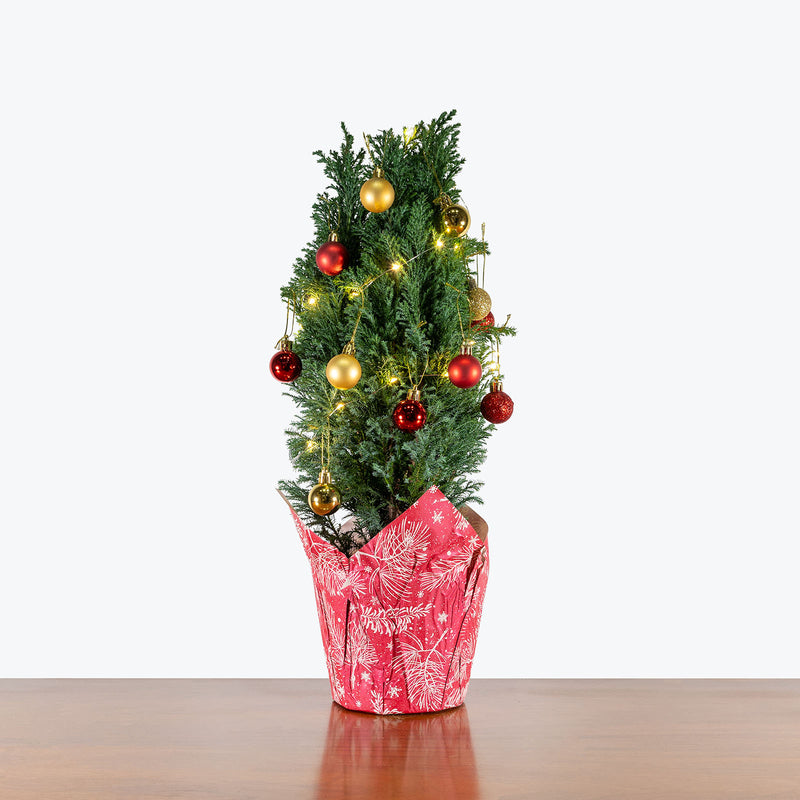
How to care for Mini Christmas Tree DIY Kit
European Cypress enjoys some direct sun, but they'll also do well in bright, indirect light. It is best to place this plant somewhere where it will receive some nice morning sun, or a couple hours of afternoon sun, and then indirect light for the rest of the day.
European Cypress will do best in bright light. A nice bright place inside your home would be on the window sill or a stool that is right next to a window, either with or without blinds, depending on if the plant can handle sun. Remember that plants will grow based on how much light they receive.
Allow the top quarter of the soil to dry before watering European Cypress again. This usually takes about 3 - 4 days in an average home environment. It will vary depending on the time of year, your environment and lighting conditions. Expect to water more often in brighter light and less often in lower light.
European Cypress will do well in average humidity environments but will appreciate a little bit of humidity if provided, give them a mist daily or get a humidifier.
Mulch around the base of the European Cypress to help retain soil moisture and regulate soil temperature when planted outdoor. Fertilize in early spring with a balanced, slow-release fertilizer formulated for evergreen trees and shrubs to promote healthy growth. Prune lightly, if necessary, in late winter or early spring to maintain shape and encourage denser foliage. Be mindful of common pests such as spider mites and scale insects, especially when grown indoors or under stress.
You can feel comfortable having European Cypress around your home in the potential case where your pet feels like nibbling on it. However, we typically recommend keeping your pets from eating any of your houseplants..
View PlantMini Green Goldfish Plant
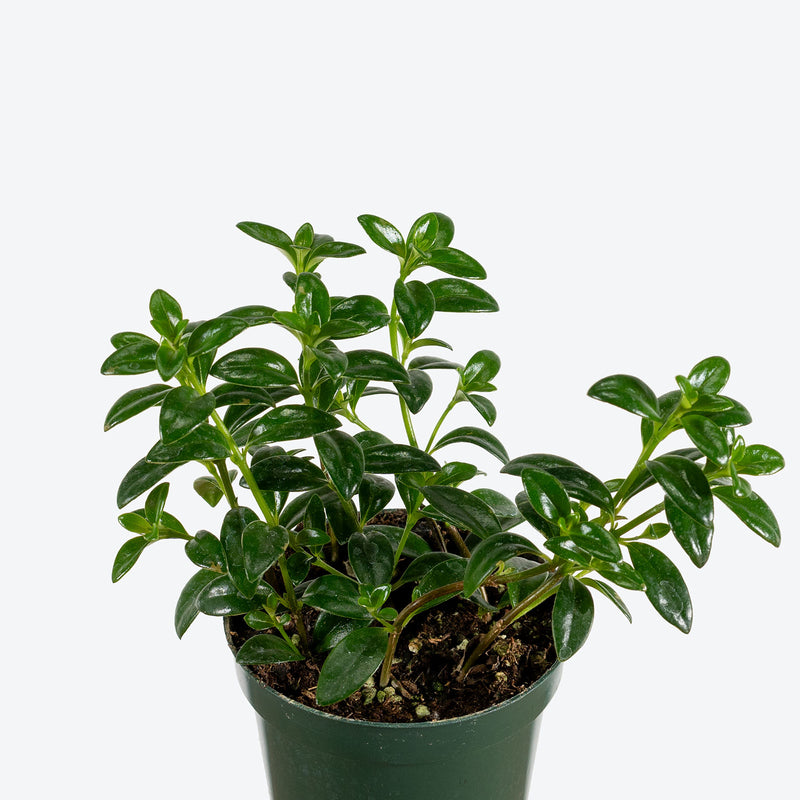
How to care for Mini Green Goldfish Plant
Mini Green Goldfish Plant should not be in a position to see the sun directly, although early morning or late evening sun is fine. Filtered sunlight through a sheer curtain is best and most homes are comprised primarily of indirect sunlight. The best spot for them is where they do not see the sun during the majority of the day but still get bright, indirect light.
Mini Green Goldfish Plant will thrive in bright light, but also can tolerate medium light. A good medium-light place in your home would be in the middle of a room that has a regular size window. They can be placed anywhere between the middle of the room and the window. Remember that plants will grow based on how much light they receive.
Mini Green Goldfish Plant needs to be watered when the top half of the soil is dry to the touch. That usually takes about 1 week in an average home environment. It will vary depending on the time of year, your environment and lighting conditions, but it's always safer to underwater or give the soil a check before you water again. Expect to water more often in brighter light and less often in lower light.
Mini Green Goldfish Plant will do well in average humidity environments but will appreciate a little bit of humidity if provided, give them a mist daily or get a humidifier.
Mini Green Goldfish Plant's colour intensity and growth shape are highly dependent on the light it receives, with bright, filtered, or dappled sunlight allowing it to perform essential functions without burning its leaves or dehydrating the plant. Prune back leggy growth to encourage bushier, more compact growth. Regularly check for common pests like aphids and spider mites, especially when grown indoors.
You can feel comfortable having Mini Green Goldfish Plant around your home in the potential case where your pet feels like nibbling on it. However, we typically recommend keeping your pets from eating any of your houseplants..
View PlantMini Phalaenopsis Orchid
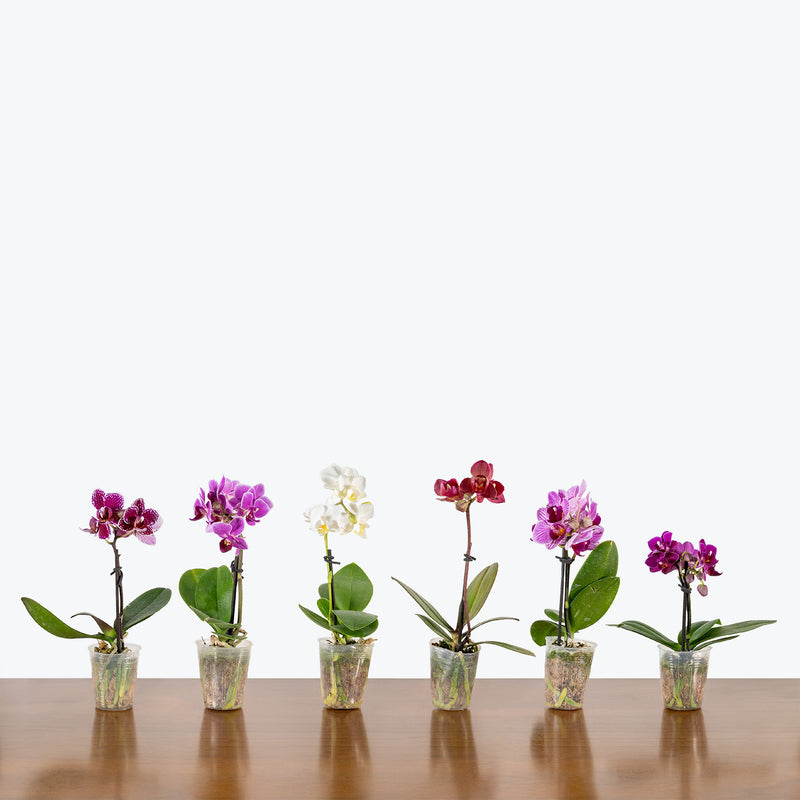
How to care for Mini Phalaenopsis Orchid
Mini Phalaenopsis Orchid should not be in a position to see the sun directly. Filtered sunlight through a sheer curtain is best and most homes are comprised primarily of indirect sunlight. The best spot for them is where they do not see the sun during the majority of the day but still get bright, indirect light.
Mini Phalaenopsis Orchid will thrive in bright light, but also can tolerate medium light. A good medium-light place in your home would be in the middle of a room that has a regular size window. They can be placed anywhere between the middle of the room and the window. Remember that plants will grow based on how much light they receive.
Mini Phalaenopsis Orchid likes the soil to be relatively dry before the next watering. That usually takes about 1 week in an average home environment, as they are typically potted in a bark mix that allows for quick drainage and good air circulation. It will vary depending on the time of year, your environment and lighting conditions, but for them, it's always safer to underwater or water when you see signs of lack of water (i.e. droopy, floppy, or soft leaves). Expect to water more often in brighter light and less often in lower light.
Mini Phalaenopsis Orchid likes a high humidity environment, give them a mist daily or as often as possible. Alternatively, you can put them around a humidifier or they are perfect for a terrarium. Although they won't die if they don't receive enough humidity, their leaves may have some dry, crunchy, or yellow edges.
To water, soak the pot in a sink filled with water for about 5 to 10 minutes, then allow it to drain completely before placing it back. Fertilize your mini Phalaenopsis orchid every other week during the growing season with a balanced, orchid-specific fertilizer diluted to half strength. During the dormant period (usually after flowering), reduce feeding to once a month. After the flowers fall, you can encourage reblooming by cutting the flower spike above the second or third node from the base.
You can feel comfortable having Mini Phalaenopsis Orchid around your home in the potential case where your pet feels like nibbling on it. However, we typically recommend keeping your pets from eating any of your houseplants..
View PlantMint Kolibri Ivy
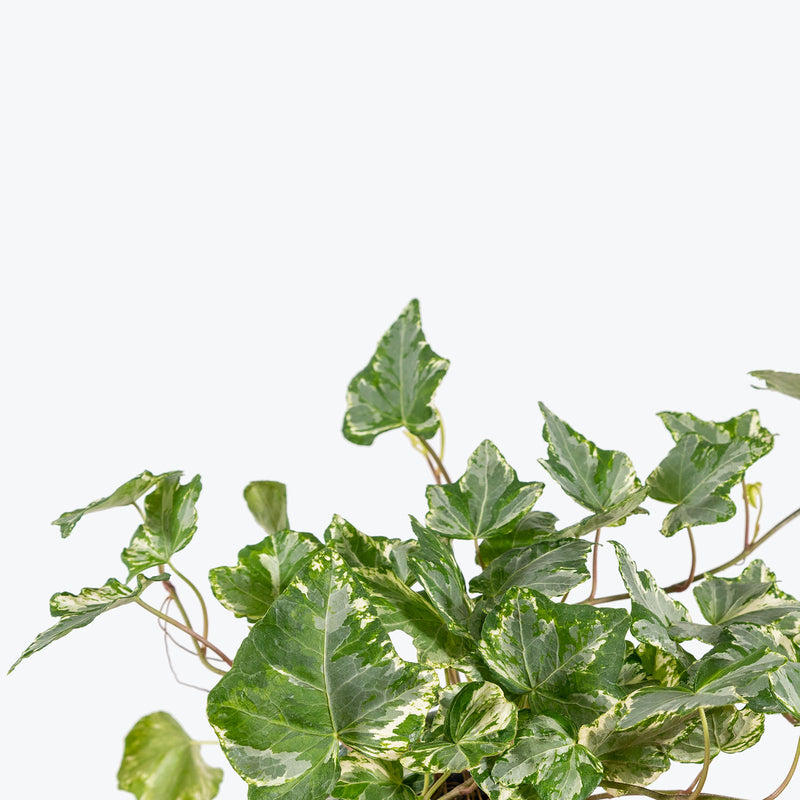
How to care for Mint Kolibri Ivy
They enjoy some direct sun, but they'll also do well in bright, indirect light. It is best to place this plant somewhere where it will receive some nice morning sun, or a couple hours of afternoon sun, and then indirect light the rest of the day.
They will do well in medium light but will grow faster with brighter light. A good medium-light place in your home would be in the middle of a room that has a regular size window. Remember that plants will grow based on how much light they receive.
They need to be watered when the top half of the soil is dry to the touch. That usually takes about 1 week in an average home environment. It will vary depending on the time of year, your environment and lighting conditions, but it's always safer to underwater or give the soil a check before you water again. Expect to water more often in brighter light and less often in lower light.
They will do well in average humidity environments but will appreciate a little bit of humidity if provided, give them a mist daily or get a humidifier.
Feel free to trim up long runners and repot them back into your plant to keep it looking bushy and full. Use sharp, clean scissors and carefully cut just below a leaf node, then remove the leaf at that node and plant that part of the stem, as that is where the roots will form. If you miss a watering or two and your ivy wilts, don't worry -- it should recover after you give it a splash of water, just take care not to overwater ivy. If your plant is given a totem to climb, it should develop bushier, more mature growth and develop sharper, triangular leaves with no lobes.
This plant is moderately toxic and can cause some adverse reactions when ingested so it is best to not let your pets eat it, which we advise for all plants in general. The severity of the reaction will depend on how much of the plant is ingested but, if you know your pet typically does not eat your plants, this plant will be suitable for your home..
View PlantMiranda Pitcher Plant
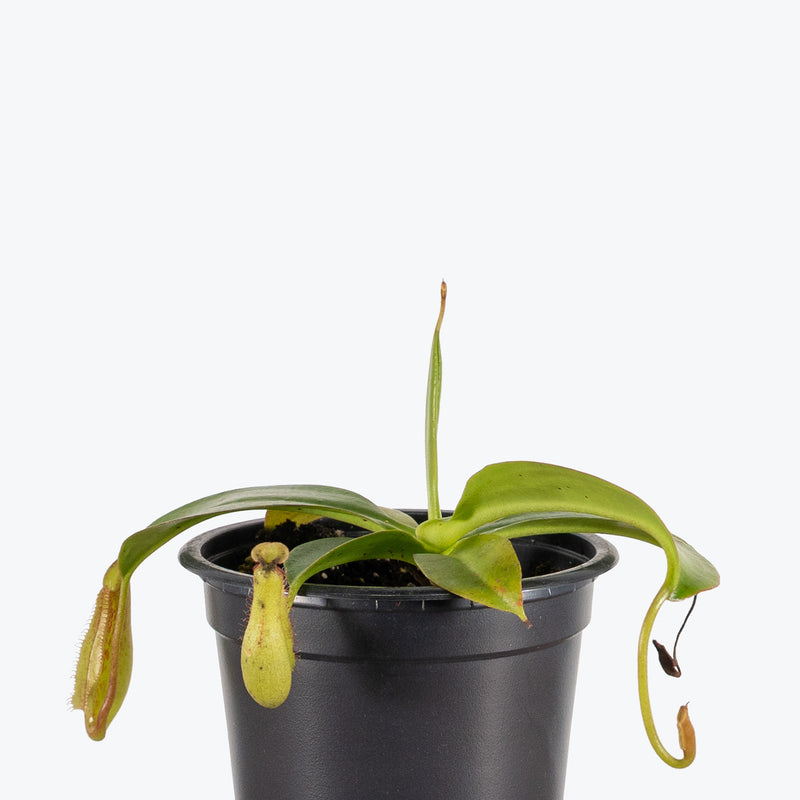
How to care for Miranda Pitcher Plant
Miranda Pitcher Plant should not be in a position to see the sun directly, although early morning or late evening sun is fine. Filtered sunlight through a sheer curtain is best and most homes are comprised primarily of indirect sunlight. The best spot for them is where they do not see the sun during the majority of the day but still get bright, indirect light.
Miranda Pitcher Plant will do best in bright light. A nice bright place inside your home would be on the window sill or a stool that is right next to a window, either with or without blinds, depending on if the plant can handle sun. Remember that plants will grow based on how much light they receive.
Allow the top quarter of the soil to dry before watering Miranda Pitcher Plant again. This usually takes about 3 - 4 days in an average home environment. It will vary depending on the time of year, your environment and lighting conditions. Expect to water more often in brighter light and less often in lower light.
Miranda Pitcher Plant likes a high humidity environment, give them a mist daily or as often as possible. Alternatively, you can put them around a humidifier. Although they won't die if they don't receive enough humidity, their leaves may have some dry, crunchy, or yellow edges.
Miranda Pitcher Plant is a fast grower and can be pruned to keep it bushy and manageable. Trimming the stems not only helps maintain its shape but also provides material for propagating new plants from cuttings. The plant is heat tolerant and does well in a warm window but should be moved outdoors in only warm weather. Ensure it is protected from extreme temperatures and brought indoors during colder months. Miranda Pitcher Plan is sensitive to minerals and chemicals often found in tap water. It's best to water them with rainwater or distilled water to avoid potential issues.
Miranda Pitcher Plant is moderately toxic and can cause some adverse reactions when ingested so it is best to not let your pets eat it, which we advise for all plants in general. The severity of the reaction will depend on how much of the plant is ingested but, if you know your pet typically does not eat your plants, this plant will be suitable for your home..
View PlantMoney Tree
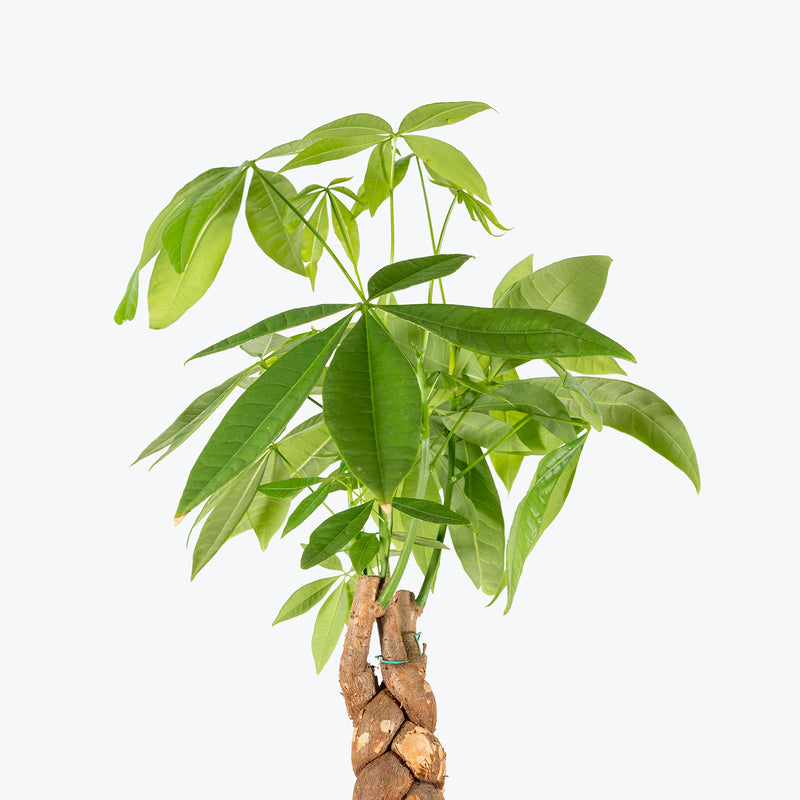
How to care for Money Tree
Pachira Aquatica Money Tree should not be in a position to see the sun directly, although early morning or late evening sun is fine. Filtered sunlight through a sheer curtain is best and most homes are comprised primarily of indirect sunlight. The best spot for them is where they do not see the sun during the majority of the day but still get bright, indirect light.
Pachira Aquatica Money Tree will do well in medium light but will grow faster with brighter light. A good medium-light place in your home would be in the middle of a room that has a regular size window. Remember that plants will grow based on how much light they receive.
Pachira Aquatica Money Tree needs to be watered when the top half of the soil is dry to the touch. That usually takes about 1 week in an average home environment. It will vary depending on the time of year, your environment and lighting conditions, but it's always safer to underwater or give the soil a check before you water again.
Pachira Aquatica Money Tree will do well in average humidity environments but will appreciate a little bit of humidity if provided, give them a mist daily or get a humidifier.
Rotate your Money Tree periodically to ensure even growth on all sides. Do not overwater Pachira Aquatica Money Tree and avoid direct sunlight can lead to leaf-scorching. Exposure to too many drafts, may cause leaf loss, so heating and air conditioning vents should be avoided. Pruning the top can help the plant to become bushier and more compact.
You can feel comfortable having Pachira Aquatica Money Tree around your home in the potential case where your pet feels like nibbling on it. However, we typically recommend keeping your pets from eating any of your houseplants..
View PlantMonstera Adansonii
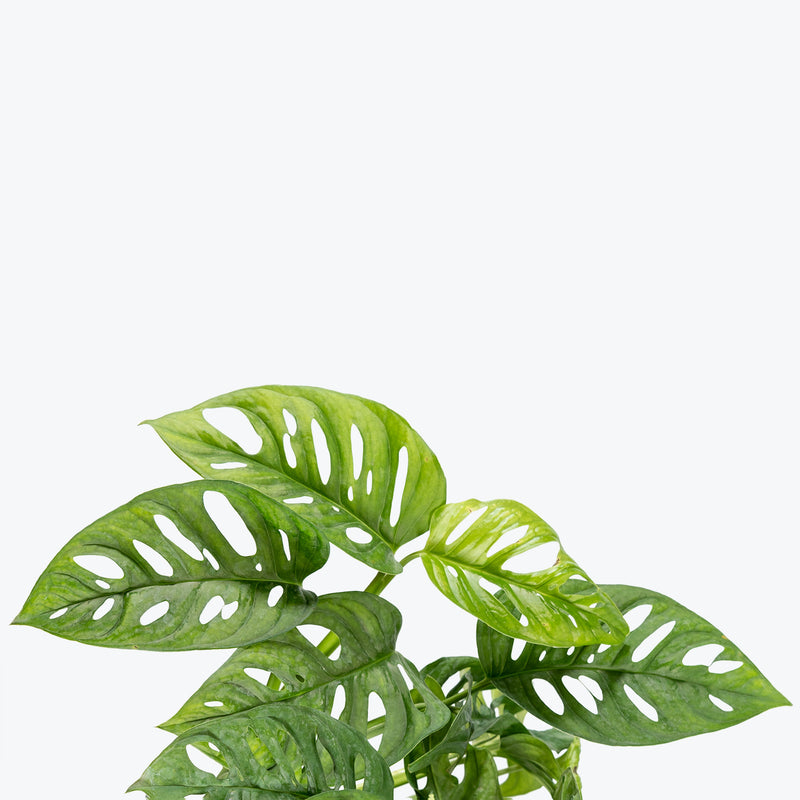
How to care for Monstera Adansonii
Monstera Adansonii should not be in a position to see the sun directly, although early morning or late evening sun is fine. Filtered sunlight through a sheer curtain is best and most homes are comprised primarily of indirect sunlight. The best spot for them is where they do not see the sun during the majority of the day but still get bright, indirect light.
Monstera Adansonii will thrive in bright light, but also can tolerate medium light. A good medium-light place in your home would be in the middle of a room that has a regular size window. They can be placed anywhere between the middle of the room and the window. Remember that plants will grow based on how much light they receive.
Monstera Adansonii likes the soil to be relatively dry before the next watering. That usually takes about 2 weeks in an average home environment. It will vary depending on the time of year, your environment and lighting conditions, but for them, it's always safer to underwater or water when you see signs of lack of water (i.e. droopy, floppy, or soft leaves). Water more often in the warmer months.
Monstera Adansonii will do well in average humidity environments but will appreciate a little bit of humidity if provided, give them a mist daily or get a humidifier.
Monstera Adansonii is very easy to look after. Give it a medium level of light and moderate watering. In spring and summer, it will appreciate a monthly feed with liquid fertilizer.
Monstera Adansonii is moderately toxic and can cause some adverse reactions when ingested so it is best to not let your pets eat it, which we advise for all plants in general. The severity of the reaction will depend on how much of the plant is ingested but, if you know your pet typically does not eat your plants, this plant will be suitable for your home..
Learn MoreView PlantMonstera Adansonii Indo Mint
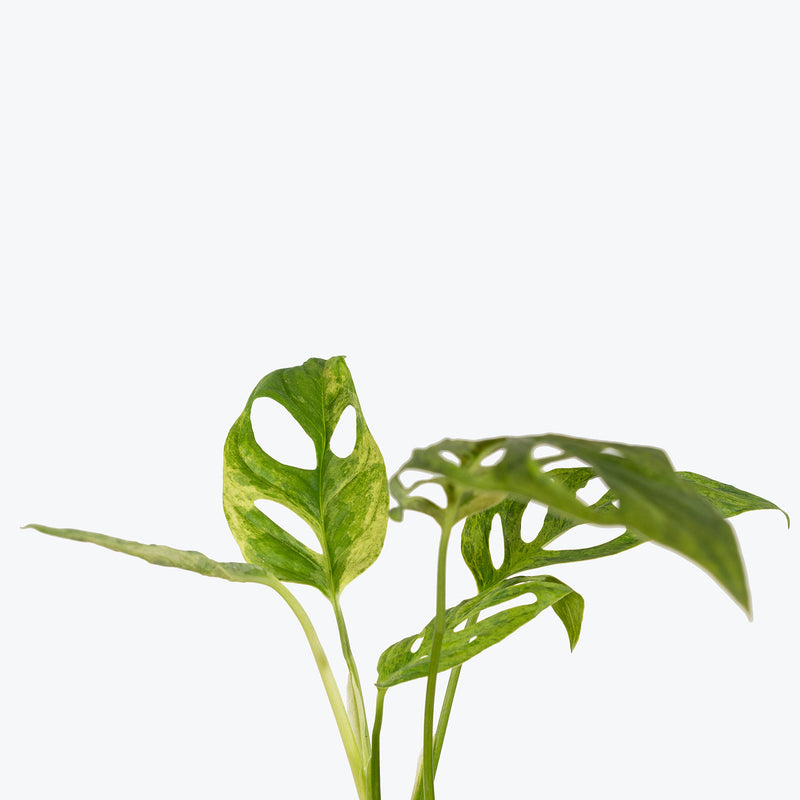
How to care for Monstera Adansonii Indo Mint
Monstera Adansonii Indo Mint should not be in a position to see the sun directly, although early morning or late evening sun is fine. Filtered sunlight through a sheer curtain is best and most homes are comprised primarily of indirect sunlight. The best spot for them is where they do not see the sun during the majority of the day but still get bright, indirect light.
Monstera Adansonii Indo Mint will thrive in bright light, but also can tolerate medium light. A good medium-light place in your home would be in the middle of a room that has a regular size window. They can be placed anywhere between the middle of the room and the window. Remember that plants will grow based on how much light they receive.
Monstera Adansonii Indo Mint needs to be watered when the top half of the soil is dry to the touch. That usually takes about 1 week in an average home environment. It will vary depending on the time of year, your environment and lighting conditions, but it's always safer to underwater or give the soil a check before you water again. Expect to water more often in brighter light and less often in lower light.
Monstera Adansonii Indo Mint likes a high humidity environment, give them a mist daily or as often as possible. Alternatively, you can put them around a humidifier. Although they won't die if they don't receive enough humidity, their leaves may have some dry, crunchy, or yellow edges.
Monstera Adansonii Indo Mint is relatively easy to look after. Please give it a medium level of light and moderate watering. In spring and summer, it will appreciate a monthly feed with liquid fertilizer. Provide support such as a moss pole to encourage vertical growth and larger leaves. Regularly clean the leaves to prevent dust accumulation, which can hinder photosynthesis.
Monstera Adansonii Indo Mint is moderately toxic and can cause some adverse reactions when ingested so it is best to not let your pets eat it, which we advise for all plants in general. The severity of the reaction will depend on how much of the plant is ingested but, if you know your pet typically does not eat your plants, this plant will be suitable for your home..
Learn MoreView PlantMonstera Albo
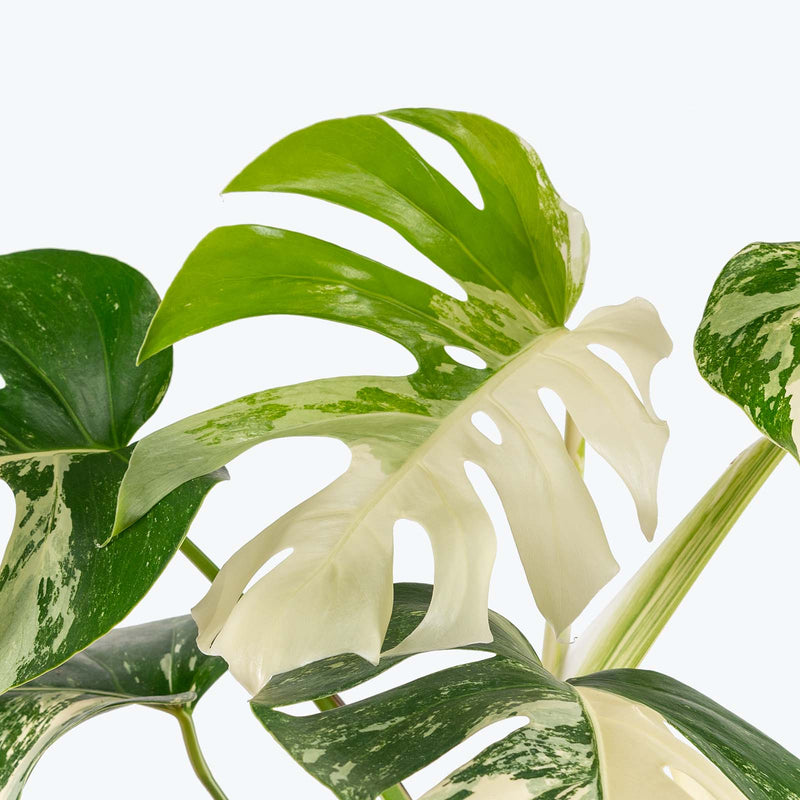
How to care for Monstera Albo
Monstera Albo should not be in a position to see the sun directly, as it is too intense for them. Filtered sunlight through a sheer curtain is fine and most homes are comprised primarily of indirect sunlight. The best spot for them is where they do not see the sun during the majority of the day but still get bright, indirect light.
Monstera Albo will thrive in bright light, but also can tolerate medium light. A good medium-light place in your home would be in the middle of a room that has a regular size window. They can be placed anywhere between the middle of the room and the window. Remember that plants will grow based on how much light they receive.
Monstera Albo needs to be watered when the top half of the soil is dry to the touch. That usually takes about 1 week in an average home environment. It will vary depending on the time of year, your environment and lighting conditions, but it's always safer to underwater or give the soil a check before you water again. Expect to water more often in brighter light and less often in lower light.
Monstera Albo will do well in average humidity environments but will appreciate a little bit of humidity if provided, give them a mist daily or get a humidifier.
Monstera Albo can be more sensitive and susceptible to nutrient deficiencies. Therefore, a balanced, slow-release fertilizer is recommended during the growing season. Be cautious about placing the plant in too dark or too bright locations, as this can either cause loss of variegation or leaf burn.
Monstera Albo is moderately toxic and can cause some adverse reactions when ingested so it is best to not let your pets eat it, which we advise for all plants in general. The severity of the reaction will depend on how much of the plant is ingested but, if you know your pet typically does not eat your plants, this plant will be suitable for your home..
Learn MoreView PlantMonstera Burle Marx Flame
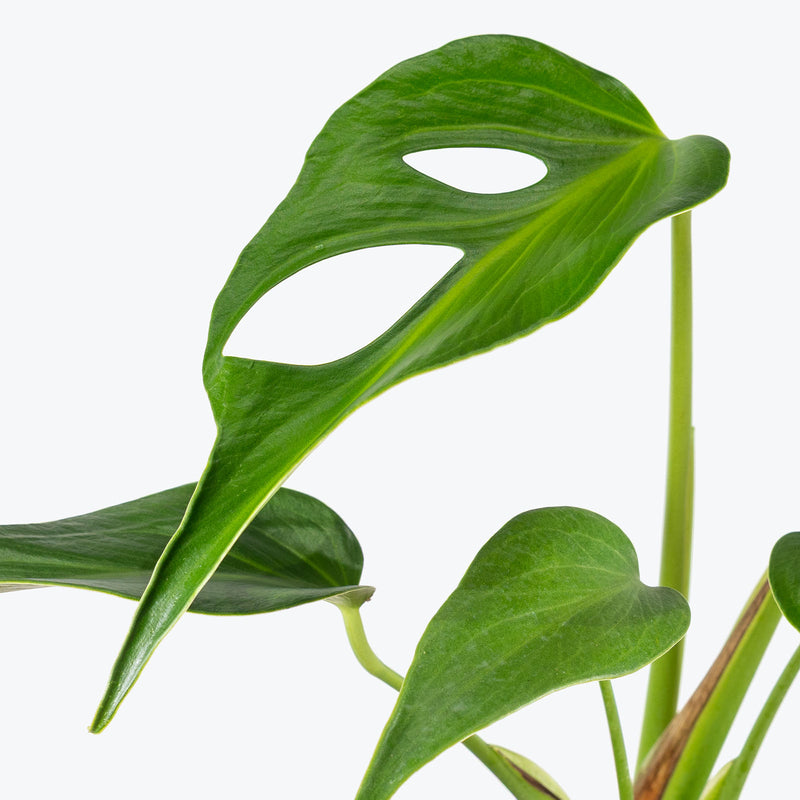
How to care for Monstera Burle Marx Flame
Monstera Burle Marx Flame should not be in a position to see the sun directly, although early morning or late evening sun is fine. Filtered sunlight through a sheer curtain is best and most homes are comprised primarily of indirect sunlight. The best spot for them is where they do not see the sun during the majority of the day but still get bright, indirect light.
Monstera Burle Marx Flame will thrive in bright light, but also can tolerate medium light. A good medium-light place in your home would be in the middle of a room that has a regular size window. They can be placed anywhere between the middle of the room and the window. Remember that plants will grow based on how much light they receive.
Monstera Burle Marx Flame needs to be watered when the top half of the soil is dry to the touch. That usually takes about 1 week in an average home environment. It will vary depending on the time of year, your environment and lighting conditions, but it's always safer to underwater or give the soil a check before you water again. Expect to water more often in brighter light and less often in lower light.
Monstera Burle Marx Flame likes a high humidity environment, give them a mist daily or as often as possible. Alternatively, you can put them around a humidifier. Although they won't die if they don't receive enough humidity, their leaves may have some dry, crunchy, or yellow edges.
Fertilize Monstera Burle Marx Flame every 4-6 weeks during the growing season with a balanced liquid fertilizer diluted to half strength. During the winter months, reduce fertilization. Provide a stake or moss pole for the plant to climb, which helps encourage leaf development and fenestration. Regularly dust the leaves to ensure efficient photosynthesis.
Monstera Burle Marx Flame is moderately toxic and can cause some adverse reactions when ingested so it is best to not let your pets eat it, which we advise for all plants in general. The severity of the reaction will depend on how much of the plant is ingested but, if you know your pet typically does not eat your plants, this plant will be suitable for your home..
Learn MoreView PlantMonstera Deliciosa
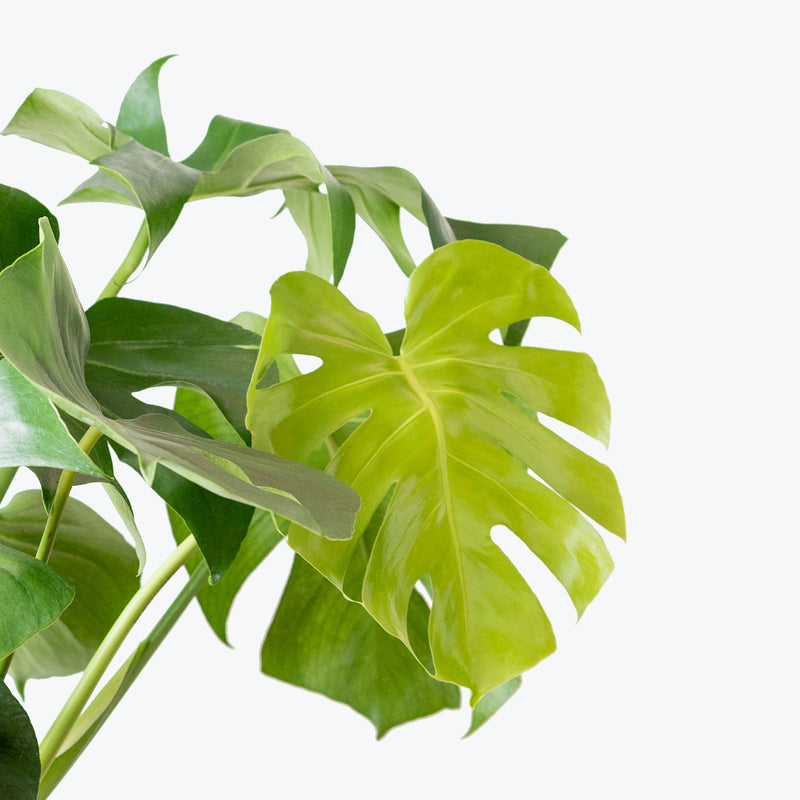
How to care for Monstera Deliciosa
Monstera Deliciosa should not be in a position to see the sun directly, as it is too intense for them. Filtered sunlight through a sheer curtain is fine and most homes are comprised primarily of indirect sunlight. The best spot for them is where they do not see the sun during the majority of the day but still get bright, indirect light.
Monstera Deliciosa will thrive in bright light, but also can tolerate medium light. A good medium-light place in your home would be in the middle of a room that has a regular size window. They can be placed anywhere between the middle of the room and the window. Remember that plants will grow based on how much light they receive.
Monstera Deliciosa likes the soil to be relatively dry before the next watering. That usually takes about two weeks in an average home environment. It may vary depending on the time of year, your environment and lighting conditions, but for them, it's always safer to underwater or water when you see signs of lack of water (i.e. droopy, floppy, or soft leaves). Water more often in the warmer months!
Monstera Deliciosa can live in any average home humidity condition and are fairly hardy. However, they will love you more if you give them some humidity.
Monstera Deliciosa are very easy to take care of, the secret is to not overwater them and pay attention to abnormal signs like yellow or falling leaves. They will also love a bit more humidity in the colder months! Water more frequently during warmer months and fertilize during growth.
Monstera Deliciosa is moderately toxic and can cause some adverse reactions when ingested so it is best to not let your pets eat it, which we advise for all plants in general. The severity of the reaction will depend on how much of the plant is ingested but, if you know your pet typically does not eat your plants, this plant will be suitable for your home..
Learn MoreView PlantMonstera Esqueleto
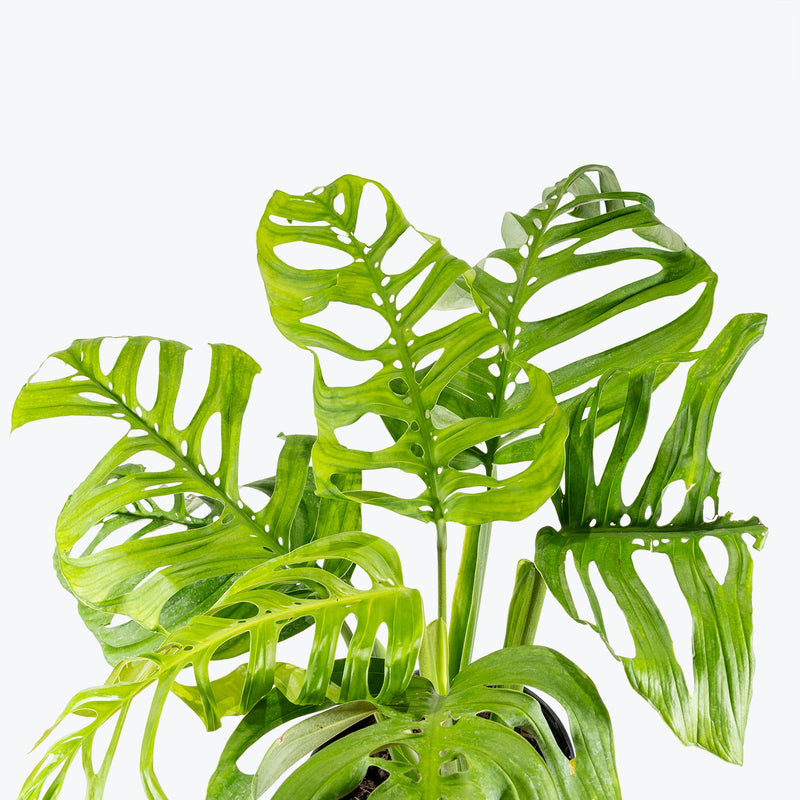
How to care for Monstera Esqueleto
Monstera Esqueleto should not be in a position to see the sun directly, although early morning or late evening sun is fine. Filtered sunlight through a sheer curtain is best and most homes are comprised primarily of indirect sunlight. The best spot for them is where they do not see the sun during the majority of the day but still get bright, indirect light.
Monstera Esqueleto will thrive in bright light, but also can tolerate medium light. A good medium-light place in your home would be in the middle of a room that has a regular size window. They can be placed anywhere between the middle of the room and the window. Remember that plants will grow based on how much light they receive.
Monstera Esqueleto likes the soil to be relatively dry before the next watering. That usually takes about 2 weeks in an average home environment. It will vary depending on the time of year, your environment and lighting conditions, but for them, it's always safer to underwater or water when you see signs of lack of water (i.e. droopy, floppy, or soft leaves). Water more often in the warmer months.
Monstera Esqueleto likes a high humidity environment, give them a mist daily or as often as possible. Alternatively, you can put them around a humidifier. Although they won't die if they don't receive enough humidity, their leaves may have some dry, crunchy, or yellow edges.
Monstera Esqueleto is very easy to look after. Ensure the plant has a support to climb on, such as a moss pole, as this will encourage larger leaf growth. Yellowing leaves can be a sign of overwatering, so adjust as necessary.
Monstera Esqueleto is moderately toxic and can cause some adverse reactions when ingested so it is best to not let your pets eat it, which we advise for all plants in general. The severity of the reaction will depend on how much of the plant is ingested but, if you know your pet typically does not eat your plants, this plant will be suitable for your home..
Learn MoreView PlantMonstera Laniata
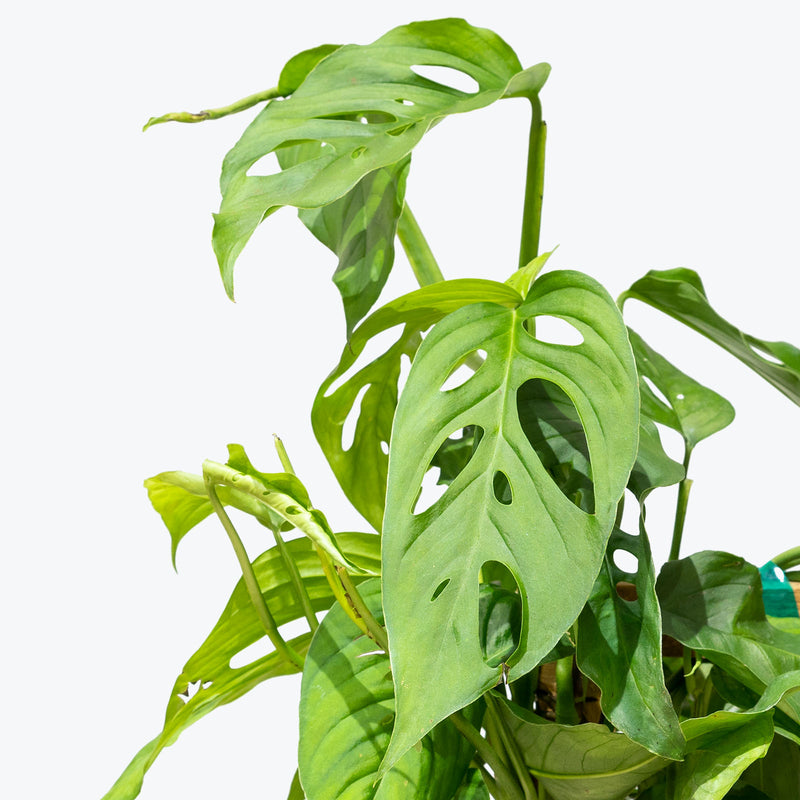
How to care for Monstera Laniata
They should not be in a position to see the sun directly, although early morning or late evening sun is fine. Filtered sunlight through a sheer curtain is best and most homes are comprised primarily of indirect sunlight. The best spot for them is where they do not see the sun during the majority of the day but still get bright, indirect light.
They will thrive in bright light, but also can tolerate medium light. A good medium-light place in your home would be in the middle of a room that has a regular size window. They can be placed anywhere between the middle of the room and the window. Remember that plants will grow based on how much light they receive.
They like the soil to be relatively dry before the next watering. That usually takes about 2 weeks in an average home environment. It will vary depending on the time of year, your environment and lighting conditions, but for them, it's always safer to underwater or water when you see signs of lack of water (i.e. droopy, floppy, or soft leaves). Expect to water more often in brighter light and less often in lower light.
They will do well in average humidity environments but will appreciate a little bit of humidity if provided, give them a mist daily or get a humidifier.
They are very easy to look after. Give it a medium level of light and moderate watering. In spring and summer, it will appreciate a monthly feed with liquid fertilizer.
This plant is moderately toxic and can cause some adverse reactions when ingested so it is best to not let your pets eat it, which we advise for all plants in general. The severity of the reaction will depend on how much of the plant is ingested but, if you know your pet typically does not eat your plants, this plant will be suitable for your home..
Learn MoreView PlantMonstera Lechleriana

How to care for Monstera Lechleriana
Monstera Lechleriana should not be in a position to see the sun directly, although early morning or late evening sun is fine. Filtered sunlight through a sheer curtain is best and most homes are comprised primarily of indirect sunlight. The best spot for them is where they do not see the sun during the majority of the day but still get bright, indirect light.
Monstera Lechleriana will thrive in bright light, but also can tolerate medium light. A good medium-light place in your home would be in the middle of a room that has a regular size window. They can be placed anywhere between the middle of the room and the window. Remember that plants will grow based on how much light they receive.
Monstera Lechleriana needs to be watered when the top half of the soil is dry to the touch. That usually takes about 1 week in an average home environment. It will vary depending on the time of year, your environment and lighting conditions, but it's always safer to underwater or give the soil a check before you water again. Expect to water more often in brighter light and less often in lower light.
Monstera Lechleriana will do well in average humidity environments but will appreciate a little bit of humidity if provided, give them a mist daily or get a humidifier.
Support your Monstera Lechleriana with a moss pole or trellis to encourage vertical growth and larger leaves. Dust the leaves regularly to ensure they can photosynthesize efficiently. During the growing season, feed the plant once a month with a balanced, water-soluble fertilizer to support its growth.
Monstera Lechleriana is moderately toxic and can cause some adverse reactions when ingested so it is best to not let your pets eat it, which we advise for all plants in general. The severity of the reaction will depend on how much of the plant is ingested but, if you know your pet typically does not eat your plants, this plant will be suitable for your home..
Learn MoreView PlantMonstera Mint
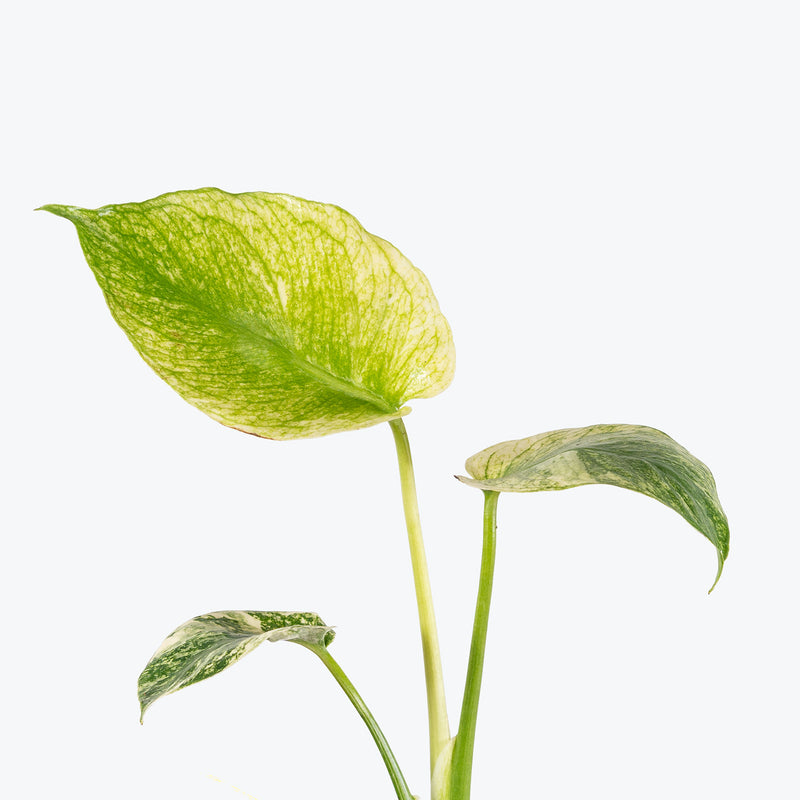
How to care for Monstera Mint
Monstera Mint should not be in a position to see the sun directly, although early morning or late evening sun is fine. Filtered sunlight through a sheer curtain is best and most homes are comprised primarily of indirect sunlight. The best spot for them is where they do not see the sun during the majority of the day but still get bright, indirect light.
Monstera Mint will do best in bright light. A nice bright place inside your home would be on the window sill or a stool that is right next to a window, either with or without blinds, depending on if the plant can handle sun. Remember that plants will grow based on how much light they receive.
Monstera Mint needs to be watered when the top half of the soil is dry to the touch. That usually takes about 1 week in an average home environment. It will vary depending on the time of year, your environment and lighting conditions, but it's always safer to underwater or give the soil a check before you water again. Expect to water more often in brighter light and less often in lower light.
Monstera Mint will do well in average humidity environments but will appreciate a little bit of humidity if provided, give them a mist daily or get a humidifier.
To keep Monstera Mint variegation strong, provide bright, indirect light and avoid extended periods of low light. Rotate the plant regularly for even growth, and support larger specimens with a moss pole or stake. Use a well-draining aroid mix, and fertilize lightly every 4–6 weeks in spring and summer to fuel healthy foliage. Prune only when needed to maintain the shape or remove fully green leaves that may appear.
Monstera Mint is moderately toxic and can cause some adverse reactions when ingested so it is best to not let your pets eat it, which we advise for all plants in general. The severity of the reaction will depend on how much of the plant is ingested but, if you know your pet typically does not eat your plants, this plant will be suitable for your home..
Learn MoreView PlantMonstera Peru
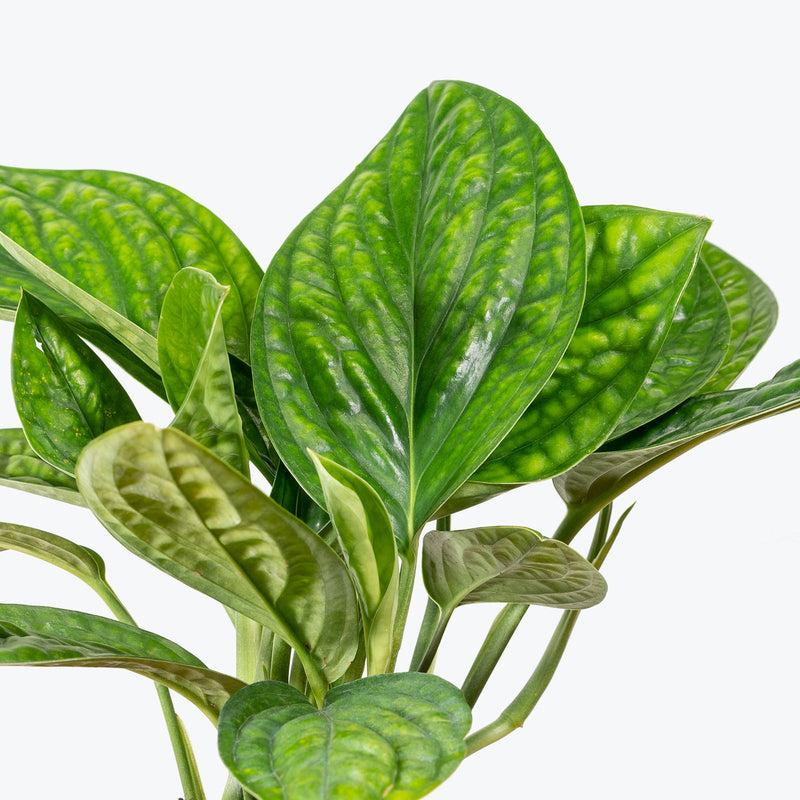
How to care for Monstera Peru
Monstera Peru should not be in a position to see the sun directly, although early morning or late evening sun is fine. Filtered sunlight through a sheer curtain is best and most homes are comprised primarily of indirect sunlight. The best spot for them is where they do not see the sun during the majority of the day but still get bright, indirect light.
Monstera Peru will do well in medium light but will grow faster with brighter light. A good medium-light place in your home would be in the middle of a room that has a regular size window. Remember that plants will grow based on how much light they receive.
Monstera Peru likes the soil to be relatively dry before the next watering. That usually takes about 2 weeks in an average home environment. It will vary depending on the time of year, your environment and lighting conditions, but for them, it's always safer to underwater or water when you see signs of lack of water (i.e. droopy, floppy, or soft leaves). Expect to water more often in brighter light and less often in lower light.
Monstera Peru can live in any average home humidity condition and are fairly hardy.
Monstera Peru can be grown as a hanging plant, but will produce bigger, more mature looking leaves when climbing on a moss pole. Fertilize every 4-6 weeks during the growing season with a balanced liquid fertilizer diluted to half strength. During the dormant winter months, reduce fertilization. Regularly clean the leaves with a damp cloth to remove dust and support efficient photosynthesis.
Monstera Peru is moderately toxic and can cause some adverse reactions when ingested so it is best to not let your pets eat it, which we advise for all plants in general. The severity of the reaction will depend on how much of the plant is ingested but, if you know your pet typically does not eat your plants, this plant will be suitable for your home..
Learn MoreView PlantMonstera Siam
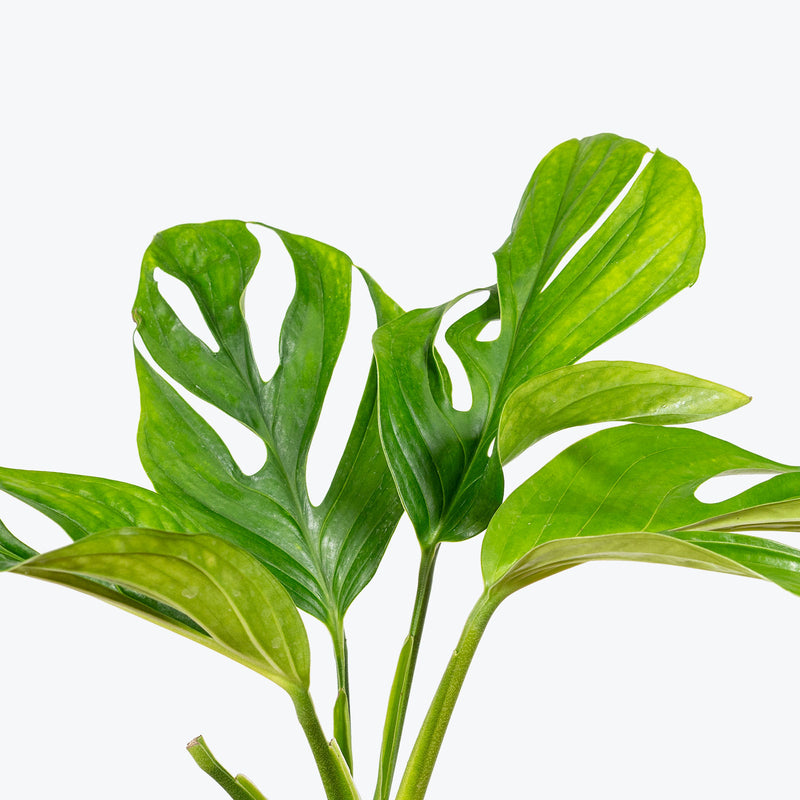
How to care for Monstera Siam
Monstera Siam should not be in a position to see the sun directly, although early morning or late evening sun is fine. Filtered sunlight through a sheer curtain is best and most homes are comprised primarily of indirect sunlight. The best spot for them is where they do not see the sun during the majority of the day but still get bright, indirect light.
Monstera Siam will do well in medium light but will grow faster with brighter light. A good medium-light place in your home would be in the middle of a room that has a regular size window. Remember that plants will grow based on how much light they receive.
Monstera Siam needs to be watered when the top half of the soil is dry to the touch. That usually takes about 1 week in an average home environment. It will vary depending on the time of year, your environment and lighting conditions, but it's always safer to underwater or give the soil a check before you water again. Expect to water more often in brighter light and less often in lower light.
Monstera Siam will do well in average humidity environments but will appreciate a little bit of humidity if provided, give them a mist daily or get a humidifier.
Encourage the development of pinnate leaves by giving Monstera Siam a moss pole or vertical support—it climbs naturally and produces more dramatic foliage when allowed to grow upward. Use a chunky, well-draining mix (Aroid Mix) and fertilize monthly during spring and summer with a balanced fertilizer. Prune lower growth to direct energy to maturing leaves.
Monstera Siam is moderately toxic and can cause some adverse reactions when ingested so it is best to not let your pets eat it, which we advise for all plants in general. The severity of the reaction will depend on how much of the plant is ingested but, if you know your pet typically does not eat your plants, this plant will be suitable for your home..
Learn MoreView PlantMonstera Sierrana
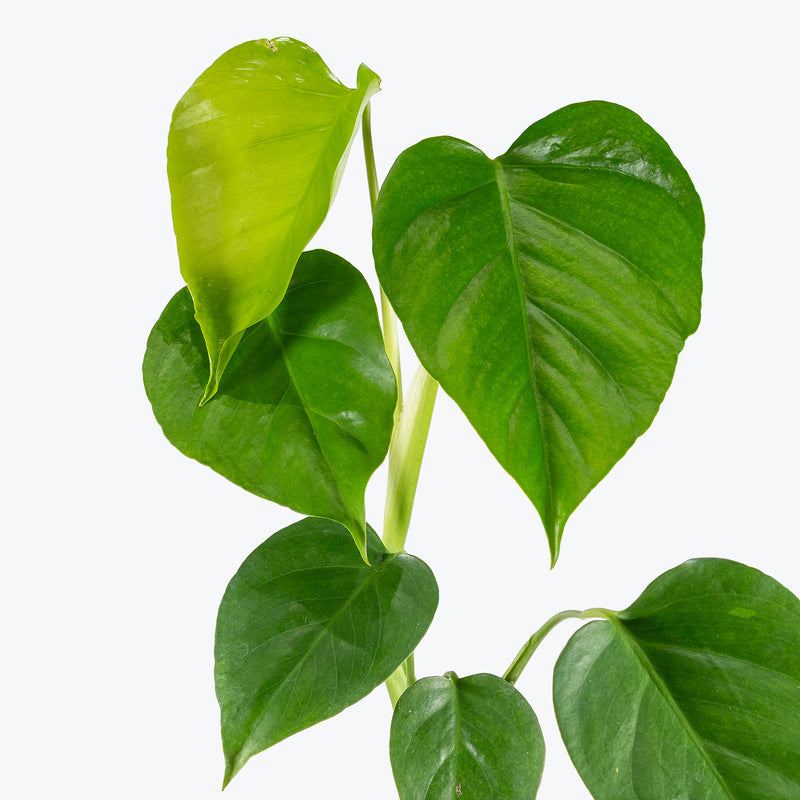
How to care for Monstera Sierrana
Monstera Sierrana should not be in a position to see the sun directly, although early morning or late evening sun is fine. Filtered sunlight through a sheer curtain is best and most homes are comprised primarily of indirect sunlight. The best spot for them is where they do not see the sun during the majority of the day but still get bright, indirect light.
Monstera Sierrana will thrive in bright light, but also can tolerate medium light. A good medium-light place in your home would be in the middle of a room that has a regular size window. They can be placed anywhere between the middle of the room and the window. Remember that plants will grow based on how much light they receive.
Monstera Sierrana needs to be watered when the top half of the soil is dry to the touch. That usually takes about 1 week in an average home environment. It will vary depending on the time of year, your environment and lighting conditions, but it's always safer to underwater or give the soil a check before you water again. Expect to water more often in brighter light and less often in lower light.
Monstera Sierrana will do well in average humidity environments but will appreciate a little bit of humidity if provided, give them a mist daily or get a humidifier.
Use a chunky, well-aerated mix — such as our Aroid Mix — to mimic natural epiphytic growing conditions. Train up a moss pole or plank to support vertical growth and encourage larger, more fenestrated leaves. Fertilize Monstera Sierrana monthly during spring and summer with a balanced formula. Wipe leaves regularly to remove dust and keep them breathing freely.
Monstera Sierrana is moderately toxic and can cause some adverse reactions when ingested so it is best to not let your pets eat it, which we advise for all plants in general. The severity of the reaction will depend on how much of the plant is ingested but, if you know your pet typically does not eat your plants, this plant will be suitable for your home..
Learn MoreView PlantMonstera Siltepecana
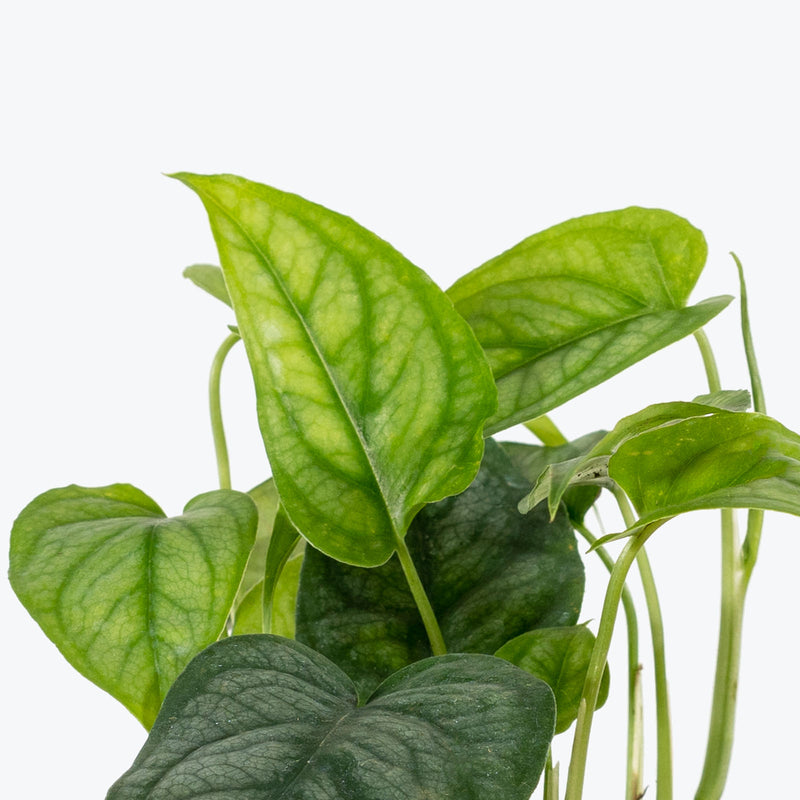
How to care for Monstera Siltepecana
Monstera Siltepecana should not be in a position to see the sun directly, although early morning or late evening sun is fine. Filtered sunlight through a sheer curtain is best and most homes are comprised primarily of indirect sunlight. The best spot for them is where they do not see the sun during the majority of the day but still get bright, indirect light.
Monstera Siltepecana will thrive in bright light, but also can tolerate medium light. A good medium-light place in your home would be in the middle of a room that has a regular size window. They can be placed anywhere between the middle of the room and the window. Remember that plants will grow based on how much light they receive.
Monstera Siltepecana needs to be watered when the top half of the soil is dry to the touch. That usually takes about 1 week in an average home environment. It will vary depending on the time of year, your environment and lighting conditions, but it's always safer to give the soil a check before you water again. Expect to water more often in brighter light and less often in lower light.
Monstera Siltepecana will do well in average humidity environments but will appreciate a little bit of humidity if provided, give them a mist daily or get a humidifier.
In the proper conditions, Monstera Siltepecana can grow quite quickly! To propagate, make cuttings at a node, which is where the leaf (and the attached petiole) attaches onto the stem or vine, and place them in water or soil to grow a bit. Make sure that each cutting has one or two leaves, and that you place at least one node underwater or under the soil line. Avoid letting the soil dry out fully, as this can lead to yellowing and loss of leaves.
Monstera Siltepecana is moderately toxic and can cause some adverse reactions when ingested so it is best to not let your pets eat it, which we advise for all plants in general. The severity of the reaction will depend on how much of the plant is ingested but, if you know your pet typically does not eat your plants, this plant will be suitable for your home..
Learn MoreView PlantMonstera Standleyana
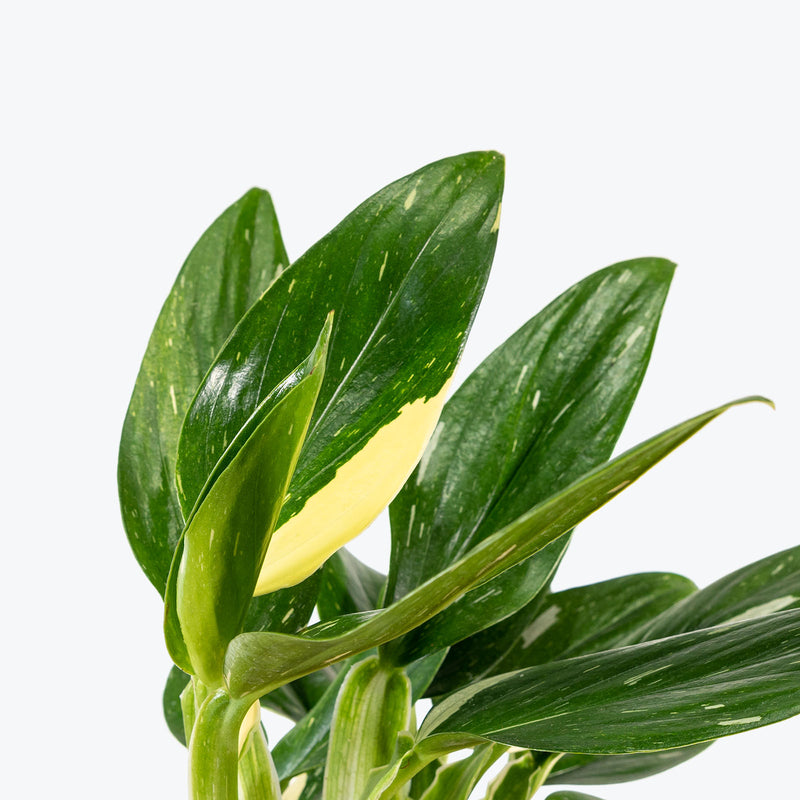
How to care for Monstera Standleyana
They should not be in a position to see the sun directly, although early morning or late evening sun is fine. Filtered sunlight through a sheer curtain is best and most homes are comprised primarily of indirect sunlight. The best spot for them is where they do not see the sun during the majority of the day but still get bright, indirect light.
They will do well in medium light but will grow faster with brighter light. A good medium-light place in your home would be in the middle of a room that has a regular size window. Remember that plants will grow based on how much light they receive.
They need to be watered when the top half of the soil is dry to the touch. That usually takes about 1 week in an average home environment. It will vary depending on the time of year, your environment and lighting conditions, but it's always safer to underwater or give the soil a check before you water again. Expect to water more often in brighter light and less often in lower light.
They like a high humidity environment, give them a mist daily or as often as possible. Alternatively, you can put them around a humidifier. Although they won't die if they don't receive enough humidity, their leaves may have some dry, crunchy, or yellow edges.
To propagate, make cuttings at a node, which is where the leaf (and the attached petiole) attaches onto the stem or vine, and place them in water or soil to grow a bit. Make sure that each cutting has one or two leaves, and that you place at least one node underwater or under the soil line.
This plant is moderately toxic and can cause some adverse reactions when ingested so it is best to not let your pets eat it, which we advise for all plants in general. The severity of the reaction will depend on how much of the plant is ingested but, if you know your pet typically does not eat your plants, this plant will be suitable for your home..
Learn MoreView PlantMonstera Thai Constellation
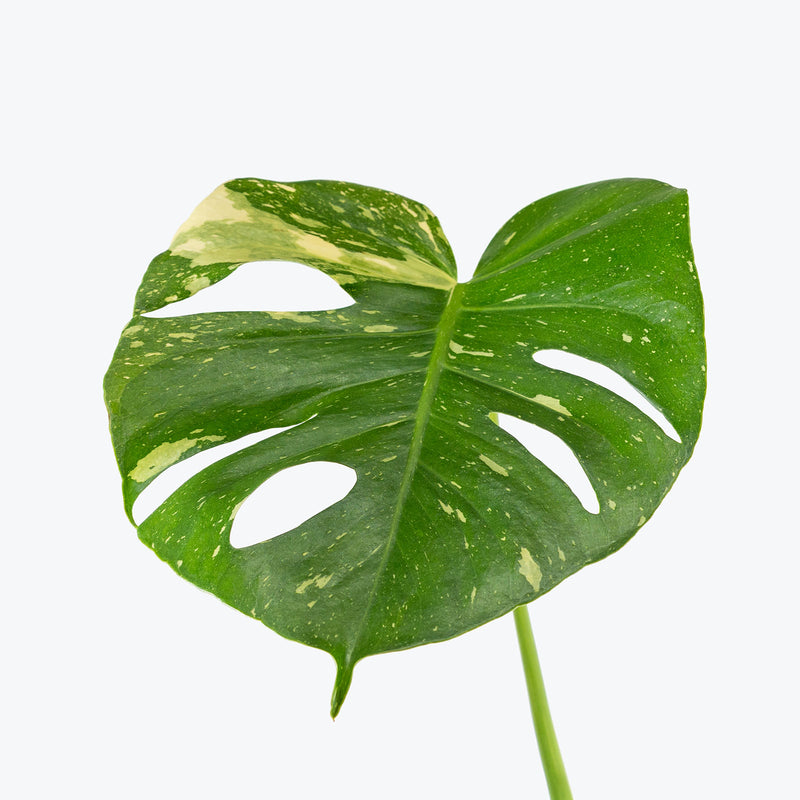
How to care for Monstera Thai Constellation
Monstera Thai Constellation should not be in a position to see the sun directly, as it is too intense for them. Filtered sunlight through a sheer curtain is fine and most homes are comprised primarily of indirect sunlight. The best spot for them is where they do not see the sun during the majority of the day but still get bright, indirect light.
Monstera Thai Constellation will thrive in bright light, but also can tolerate medium light. A good medium-light place in your home would be in the middle of a room that has a regular size window. They can be placed anywhere between the middle of the room and the window. Remember that plants will grow based on how much light they receive.
Monstera Thai Constellation likes the soil to be relatively dry before the next watering. That usually takes about two weeks in an average home environment. It may vary depending on the time of year, your environment and lighting conditions, but for them, it's always safer to underwater or water when you see signs of lack of water (i.e. droopy, floppy, or soft leaves). Water more often in the warmer months!
Monstera Thai Constellation can live in any average home humidity condition and are fairly hardy. However, they will love you more if you give them some humidity.
Since Monstera Thai Constellation have variegation, they will need brighter light than the original Monstera Deliciosa, but still, avoid direct sun. They are very easy to take care of, the secret is to not overwater them and pay attention to abnormal signs like yellow or falling leaves. They will also love a bit more humidity in the colder months! Water more frequently during warmer months and fertilize during growth. Rotate the plant occasionally to ensure even growth.
Monstera Thai Constellation is moderately toxic and can cause some adverse reactions when ingested so it is best to not let your pets eat it, which we advise for all plants in general. The severity of the reaction will depend on how much of the plant is ingested but, if you know your pet typically does not eat your plants, this plant will be suitable for your home..
Learn MoreView PlantMonstera White Monster
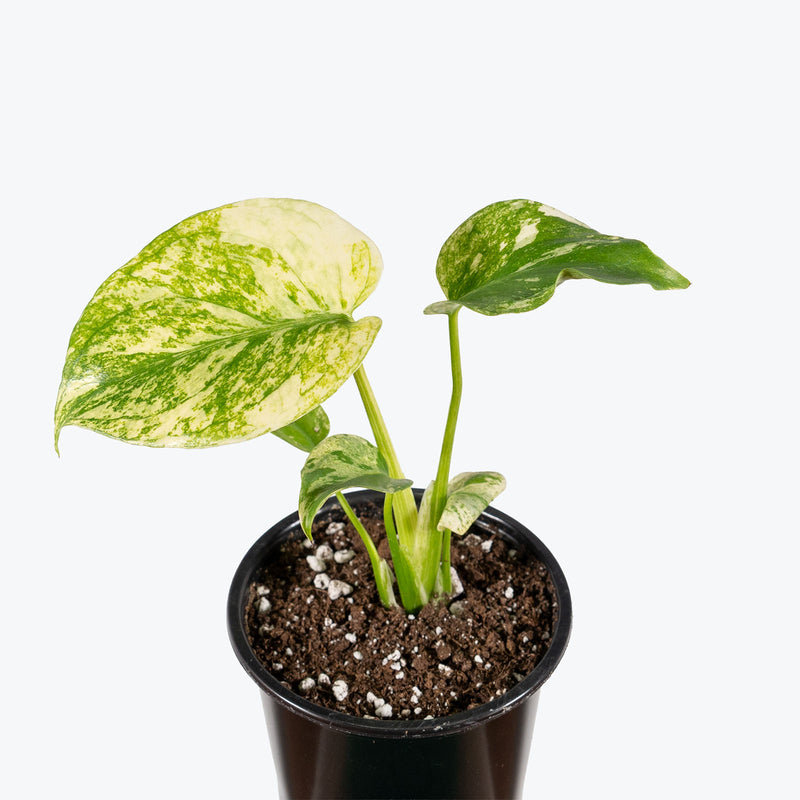
How to care for Monstera White Monster
Monstera White Monster should not be in a position to see the sun directly, although early morning or late evening sun is fine. Filtered sunlight through a sheer curtain is best and most homes are comprised primarily of indirect sunlight. The best spot for them is where they do not see the sun during the majority of the day but still get bright, indirect light.
Monstera White Monster will do best in bright light. A nice bright place inside your home would be on the window sill or a stool that is right next to a window, either with or without blinds, depending on if the plant can handle sun. Remember that plants will grow based on how much light they receive.
Monstera White Monster needs to be watered when the top half of the soil is dry to the touch. That usually takes about 1 week in an average home environment. It will vary depending on the time of year, your environment and lighting conditions, but it's always safer to underwater or give the soil a check before you water again. Expect to water more often in brighter light and less often in lower light.
Monstera White Monster will do well in average humidity environments but will appreciate a little bit of humidity if provided, give them a mist daily or get a humidifier.
To preserve strong variegation on Monstera White Monster, provide bright, indirect light — insufficient light can lead to more green-dominant growth. Avoid letting water sit in the soil; a chunky, well-draining aroid mix is best. Use a moss pole or stake to support vertical growth. Prune carefully to encourage balanced variegation, and remove solid green leaves if needed. Fertilize monthly in spring and summer with a diluted, balanced fertilizer.
Monstera White Monster is moderately toxic and can cause some adverse reactions when ingested so it is best to not let your pets eat it, which we advise for all plants in general. The severity of the reaction will depend on how much of the plant is ingested but, if you know your pet typically does not eat your plants, this plant will be suitable for your home..
Learn MoreView PlantMonstera Yellow Marilyn
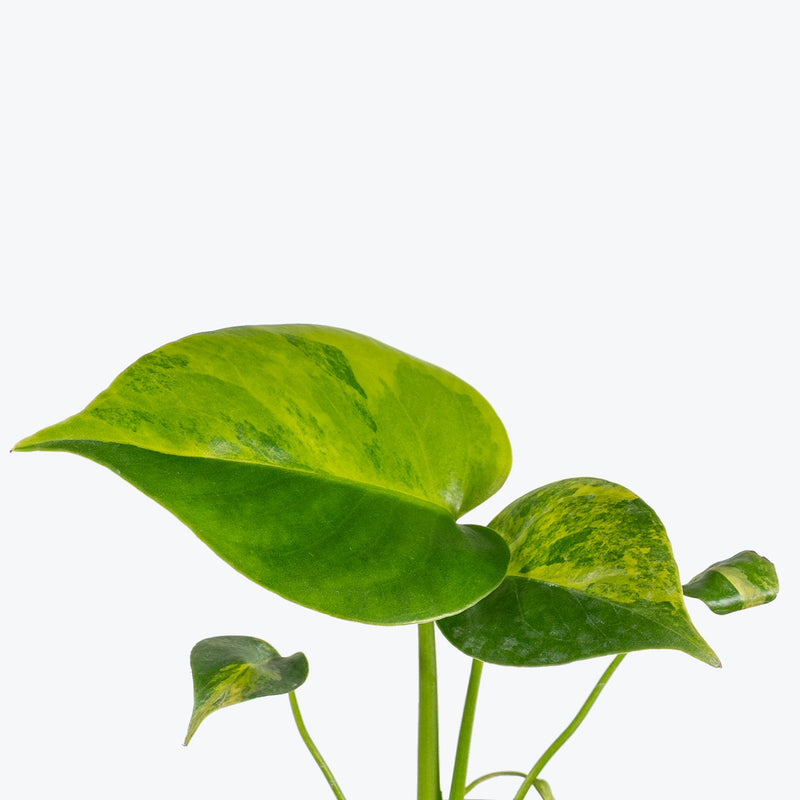
How to care for Monstera Yellow Marilyn
Monstera Yellow Marilyn should not be in a position to see the sun directly, although early morning or late evening sun is fine. Filtered sunlight through a sheer curtain is best and most homes are comprised primarily of indirect sunlight. The best spot for them is where they do not see the sun during the majority of the day but still get bright, indirect light.
Monstera Yellow Marilyn will do best in bright light. A nice bright place inside your home would be on the window sill or a stool that is right next to a window, either with or without blinds, depending on if the plant can handle sun. Remember that plants will grow based on how much light they receive.
Monstera Yellow Marilyn needs to be watered when the top half of the soil is dry to the touch. That usually takes about 1 week in an average home environment. It will vary depending on the time of year, your environment and lighting conditions, but it's always safer to underwater or give the soil a check before you water again. Expect to water more often in brighter light and less often in lower light.
Monstera Yellow Marilyn will do well in average humidity environments but will appreciate a little bit of humidity if provided, give them a mist daily or get a humidifier.
Fertilize Monstera Yellow Marilyn every month during the growing season (spring through summer) with a balanced, liquid fertilizer. During the dormant winter months, reduce feeding to once every two months. Clean the leaves occasionally with a damp cloth to remove dust and support photosynthesis. Support the climbing habit with a moss pole or trellis to encourage vertical growth and larger leaf development.
Monstera Yellow Marilyn is moderately toxic and can cause some adverse reactions when ingested so it is best to not let your pets eat it, which we advise for all plants in general. The severity of the reaction will depend on how much of the plant is ingested but, if you know your pet typically does not eat your plants, this plant will be suitable for your home..
Learn MoreView PlantMoon Cactus
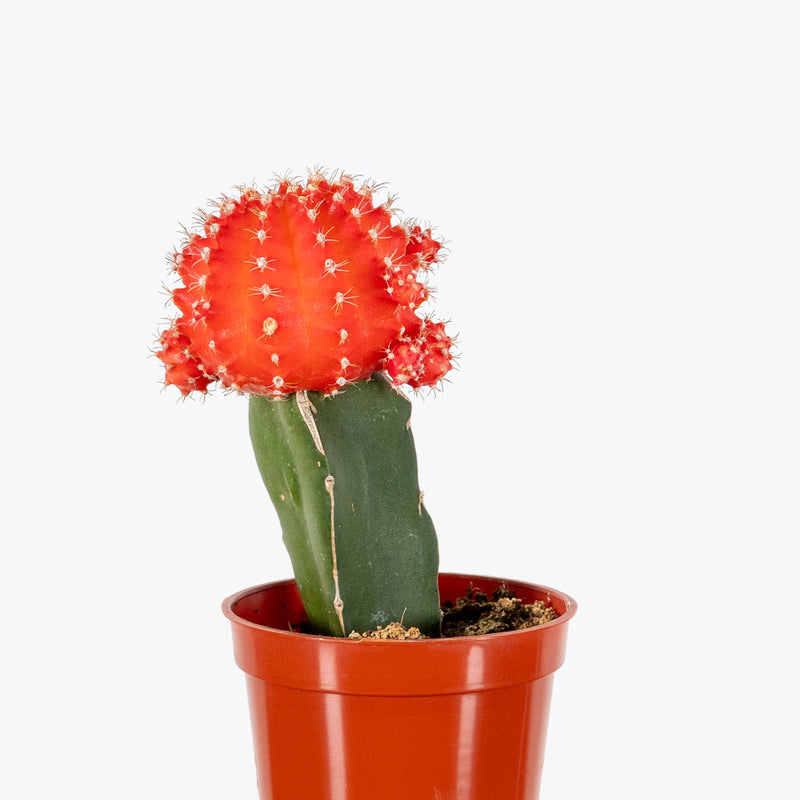
How to care for Moon Cactus
They enjoy some direct sun, but they'll also do well in bright, indirect light. It is best to place this plant somewhere where it will receive some nice morning sun, or a couple hours of afternoon sun, and then indirect light the rest of the day.
They will do best in bright light. A nice bright place inside your home would be on the window sill or a stool that is right next to a window, either with or without blinds, depending on if the plant can handle sun. Remember that plants will grow based on how much light they receive.
They like the soil to be completely dry before the next watering. This can take up to 4 weeks in an average home environment but it will vary depending on the time of year, your environment and lighting conditions. For them, it's always safer to underwater or water when you see signs of lack of water (i.e. wrinkly or soft leaves). Water a little more often in the warmer months.
Their humidity requirement is low, so do not mist them or put them in a terrarium.
Be sure not to water directly on the plant itself, but rather on the soil around the plant, because if water gets into the folds, it may lead to rot. They also prefer to have a crowded home, which means you can repot in the same pot for several years.
This plant is moderately toxic and can cause some adverse reactions when ingested so it is best to not let your pets eat it, which we advise for all plants in general. The severity of the reaction will depend on how much of the plant is ingested but, if you know your pet typically does not eat your plants, this plant will be suitable for your home..
Learn MoreView PlantMother Of Thousands
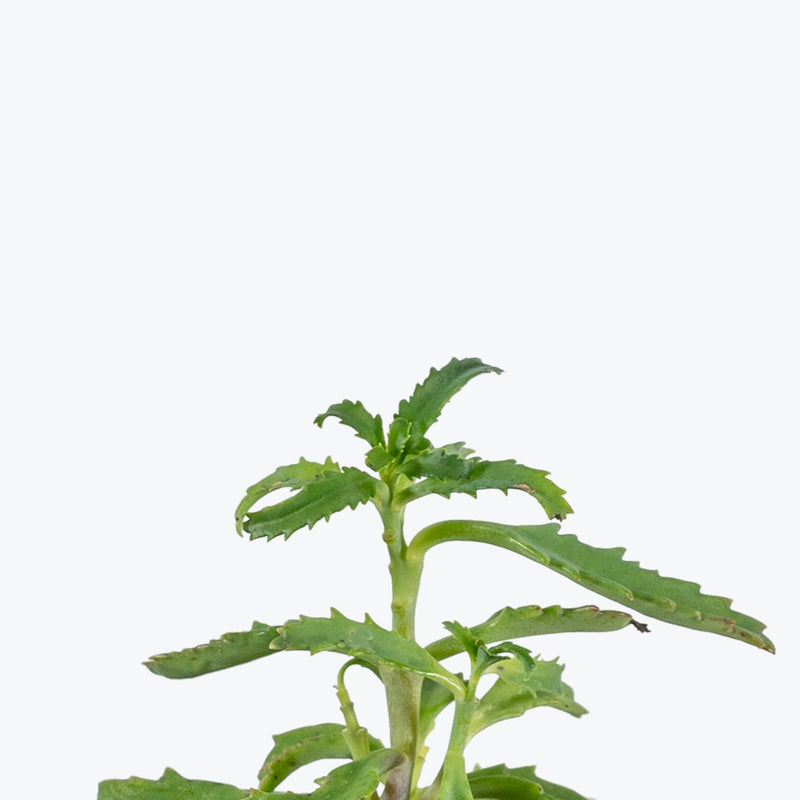
How to care for Mother Of Thousands
They enjoy some direct sun, but they'll also do well in bright, indirect light. It is best to place this plant somewhere where it will receive some nice morning sun, or a couple hours of afternoon sun, and then indirect light the rest of the day.
They will do best in bright light. A nice bright place inside your home would be on the window sill or a stool that is right next to a window, either with or without blinds, depending on if the plant can handle sun. Remember that plants will grow based on how much light they receive.
They like the soil to be completely dry before the next watering. This can take up to 4 weeks in an average home environment but it will vary depending on the time of year, your environment and lighting conditions. For them, it's always safer to underwater or water when you see signs of lack of water (i.e. wrinkly or soft leaves). Water a little more often in the warmer months.
Their humidity requirement is low, so do not mist them or put them in an enclosed terrarium.
Due to its prolific nature, this plant can quickly take over a space if not managed. Be mindful of where the baby plants drop, as they easily root wherever they land.
This plant is moderately toxic and can cause some adverse reactions when ingested so it is best to not let your pets eat it, which we advise for all plants in general. The severity of the reaction will depend on how much of the plant is ingested but, if you know your pet typically does not eat your plants, this plant will be suitable for your home..
View Plant



